A guide on black bream fishing from the shore and boat, this comprehensive article looks at where to fish, top tactics, tackle and bait.
A summer visitor to UK and Irish waters, black bream are noted for their hard fighting abilities on appropriately light tackle, plus it’s rated as one of the very best fish to eat. In fact, black bream were a favourite on the menu during Roman times, this has been proven by their bones having been found in excavated rubbish pits during archaeological digs in the southern half of the UK.
Anglers find it annoying, but they are often referred to as “sea bream” by chefs trying to avoid any connection with freshwater bream.
Black bream are pretty easy to identify. They are oval with a small, angled at the front, head. The jaw junction extends only as far as the front line of the eye or slightly less so. It has small pointed teeth.
Its overall colouration depends on the depth at which it is living. In shallower water the fish is mostly silver with a slightly bluish tinge to the back. In younger fish there may be a series of vertical bars running down the flanks. The body is covered in medium-sized scales. In deeper water the fish takes on a darker blue to black back, with silver sides and sometimes there is a hint of yellow behind the head and on the flanks.
Only three other bream may cause identification confusion. One is the red sea bream which has become very rare, almost non-existent in UK waters, but these have an obviously more rounded head and more elongated body. It has a large eye, and the scales on the head extend only as far as the middle of the eye line. They have rose-coloured or reddish-grey backs, the sides with a pink flush and the fins are greyish red. A good ID point is the dark blotch or mark they carry on their upper side between the inner front line of the dorsal fin and the upper gill cover.
Gilthead bream have an obvious gold-band running across their forehead, making it easy to separate the two.
Couch’s bream really only extend as far as the Channel Islands and the Scilly Islands, with a few making it to the southern English Channel. They are a very thick set bream with a more rounded head than the black bream. They’re colouration is rosy on the back with silver sides and pink fins but the tail fin edges are tipped in white.
Most black bream caught are smaller fish up to 2lbs, but a bream over 3.5lbs in the UK would be needed to reach specimen weight. In Ireland, where bream are less common, a fish of 1.75lbs would be enough. The maximum weight for the species is thought to be about 7lbs.
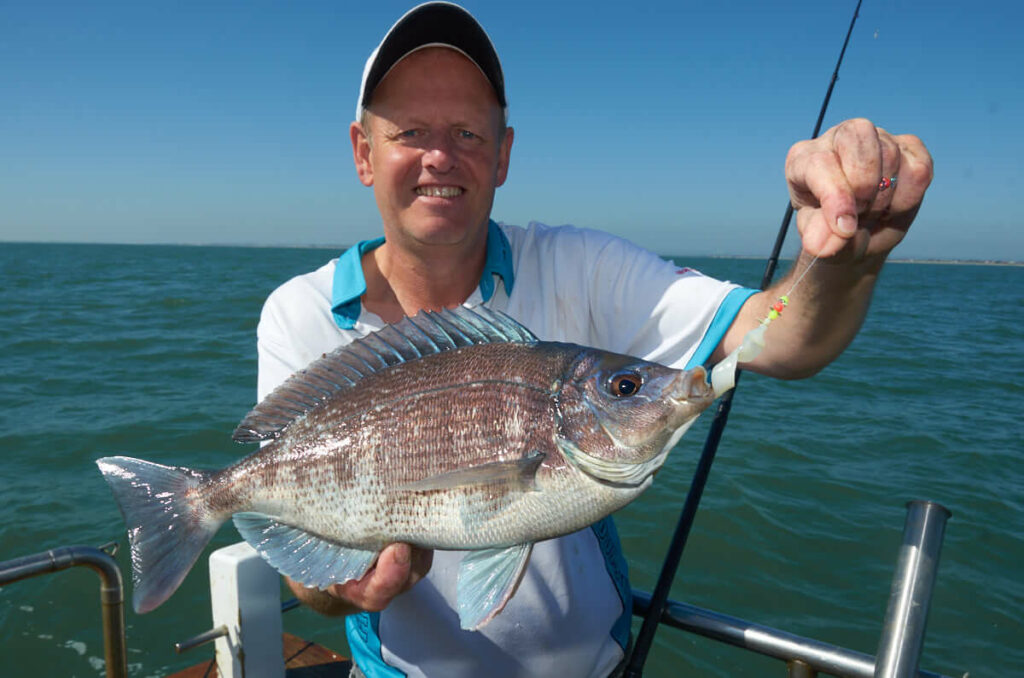
Black bream are found from North Africa, throughout the Mediterranean, and up the European coast as far as Holland, though only rarely further north, though they have been recorded in southern Norway.
In the UK, they are caught along the English Channel coast, and will work into the southern North Sea off the Kent coast. They are most common on the west facing coasts of the UK being found off Devon and Cornwall, off west and mid Wales inside Cardigan Bay, and to a lesser degree off the North Wales coast, especially Anglesey. Black Bream are also caught inside Morecambe Bay and as far north as the Mull of Galloway in Scotland.
In Ireland, their distribution is less wide, being mainly concentrated off the Wicklow coast and in Wexford around Kilmore Quay.
Bream usually appear back in the English Channel and the Southwest in mid to late April and are well established by the end of May. It’s usually mid-May they appear in Cardigan Bay in mid Wales, and in Morecambe Bay and the Mull of Galloway by mid-June.
Their numbers peak in July and August, but they quickly disappear from the more northern marks by early September, from mid Wales by mid-September, and then from the English Channel by early October close to shore, but the deeper water wrecks may hold good numbers of bream until the end of October.
Their habitat is quite varied, but commonly the bigger fish are found over reef ground both close inshore in shallow water, but also deeper water exceeding 100-feet. They also frequent wrecks in deeper water and it’s these that can produce the very biggest fish. Smaller fish are often found around pier and jetty supports in deeper water and in schools of hundreds. They are also lovers of eelgrass beds and will feed in just a few feet of water when working through these and are targeted by dinghy anglers and kayakers.
It is thought that the black bream breeds in UK waters in April and May in the English Channel, but as late as June in Cardigan Bay in mid Wales.
They are one of the few fish to actually build a nest, usually a scooped out area in sand or fine shingle among reef ground, for the deposited eggs to mature in. The male guards the nest until the young hatch. They then form a shoal around the nest for several weeks before going their separate ways.
As for diet, the black bream is quite casual and will eat almost anything including crustaceans, shellfish, shrimps, worms, as well as small fish. In fact, the bigger adults can become very predatory taking any small fish it finds, especially on the reef and wrecks with shannies and gobies, the principal species.
They are a shoal fish and form large shoals with the more competitive smaller fish at the head of the shoal and the wiser bigger fish at the rear.
They feed best when there is a good run of tide, but much depends on where you’re fishing as to which tides are best.
In deeper water, say in the English Channel, then the smaller neap tides may prove best as the tide will flow less fast. This allows you easier anchoring, or when drift fishing the drift is slower giving the black bream better opportunity to take the bait. Also, when anchoring, the flowing tide allows the boat to anchor well uptide of the wreck or reef and let the scent wash into the structure which will bring the bream out to investigate.
In shallower areas with less overall tide run, such as Cardigan Bay in mid Wales, then you’re often only fishing in 15 to 40-feet of water generally and the bigger tides will fish better and for longer. During the weaker flowing neap tides, the fishing will tend to be more concentrated within the middle hours of the flood and ebb, with the periods of slack water proving way less successful.
Black Bream feed best during the middle of the flooding tide, and again during the middle of the ebbing tide when the flow is strongest. During slack water periods bites usually fall away to next to nothing but come back on as soon as the flow starts to pick up.
In deeper water, such as when fishing offshore wrecks, bream are not overly affected by rougher seas and will stay on station throughout. When fishing wrecks in less than 100-feet depth, then during prolonged periods of rough seas, the black bream shoals will move out to deeper water, but return quickly as the sea state settles and clears again.
Neither do they like water with colour in it preferring clarity, so again, a settling sea well after the rougher seas have subsided will prove best.
When fishing shallow reefs then flat calm seas can be good, but some slight swell and a ripple on the surface water that limits the light levels entering the water column will produce better fishing. Here though, when in water less than 30-feet deep, some suspended sediment in the water will hold the fish over the reefs and in the eelgrass beds, whereas clear conditions can push them out into deeper water.
Perfect conditions for the shallower venues are an overcast sky and a light wind, but they will still feed well in bright sunlight, though these tend to be the more competitive smaller shoal fish if the water is also clear.
Bream will feed throughout the day, but if you get an opportunity to fish dawn or dusk for them just as light is breaking, or when dark is about to fall, the fishing can often be quite spectacular. They don’t feed in the dark hours, so maybe they are feeding up to sustain themselves through the night as dusk falls, and are ravenous after a night's fasting at dawn.
Even on the wrecks and reefs in deeper water, a 12lb class rod around 8-feet to 8ft 6ins in length is perfect. The modern rod design of soft tip section with early power coming in, in the upper mid section feeding through into a stiff butt is ideal for this type of fishing. Such a rod can handle weights up to 10ozs or so, and rarely should you need more if you’re fishing braid line. Also, rods of this length have that vital tip action and this encourages the fighting abilities of the bream.
The reel to go with this rod should be a smaller multiplier such as a PENN 515Mag3. This is not normally a boat fishing reel, but in this case it proves ideal and balances well with a 12lb class boat rod. Load the reel with 300yds of 20lb braid plus some mono backing.
In shallower water, be it over reefs or even in among eel-grass beds, then a much lighter option produces the very best light tackle thrills. For this fishing, choose a 7ft to 8ft spinning rod rated to cast no more than 2ozs, and match this to a 3000 sized fixed spool reel loaded with 15lb braid and short fluorocarbon shock leader again of 15lbs. This gives tremendous bite detection opportunities, but also makes the most of the breams fast head down fight, but still has the power to subdue the very biggest bream.
Some anglers fishing shallow water choose a lighter LRF or HRF rod around 7ft to 7ft 6in and rated between 15 and 20g. Add a small 2500 sized fixed spool reel loaded with 6 to 8lb braid and you’ll have a day to remember.
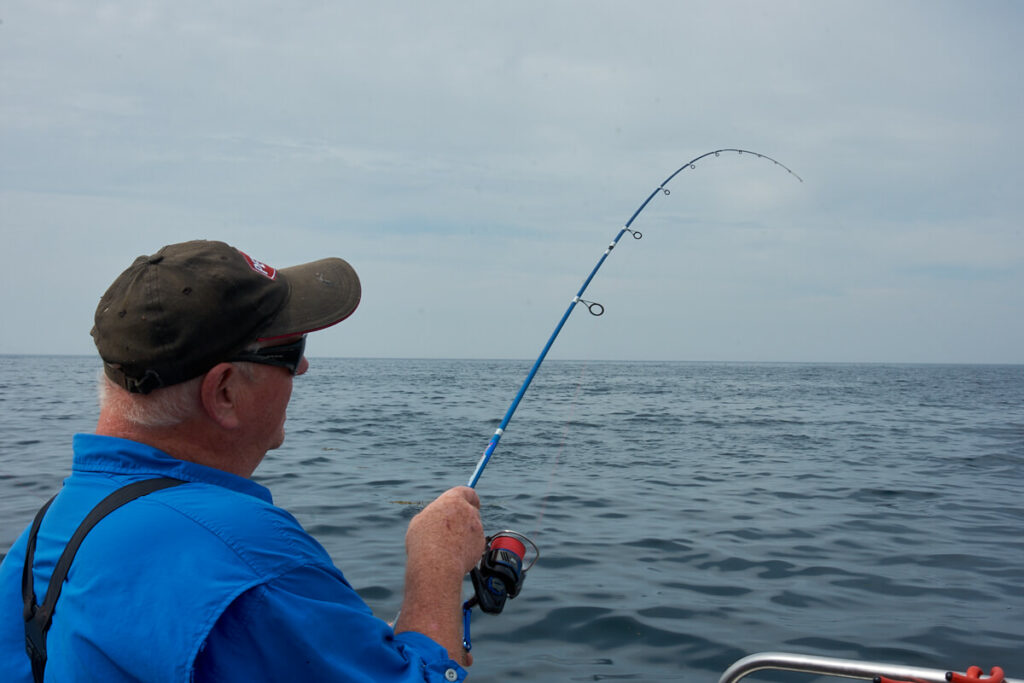
Always fish a short shock leader of fluorocarbon or mono on the end of the braid to protect it from the ravages of contact with the seabed and wreck. Also, in shallow water, the clear leader gives a visual break from the coloured braid and this can increase bites when the water is clear. The leader needs to be about twice the length of the rod so that you have some leader back on the reel when the fish is on the surface by the boat. A good guide to breaking strain is to match the main reel line and use a streamlined knot such as the Albright Knot for the braid to leader connection.
In shallower water you can get away with a mono main line as the tide run is much less. Braid is thinner in diameter than mono for the same breaking strain so is less affected by water pressure on the line. This means you can use much lighter leads than you can with the heavier diameter mono. Also, the braid does not stretch, so it will give far better bite detection than the mono will.
As with most modern fishing, carry a wide variety of lead sizes and be prepared to change. You’re looking to use just enough lead weight to keep in contact with the seabed. Bream like a moving bait, so remember this. Leads of 4ozs can often be used with lighter gear over wrecks, even if this is only during the lighter tide flow periods. 6 to 8ozs and 20lb braid is a common scenario even over deepish wrecks, so don’t fish heavier than you need to.
One of the best rigs for light tackle fishing in both shallow reefs and rough ground and in deeper water around wrecks when the tide is flowing is a 1-hook boom rig. It’s easy to tie and very effective, especially when there is some flow in the tide.
1-hook boom rig
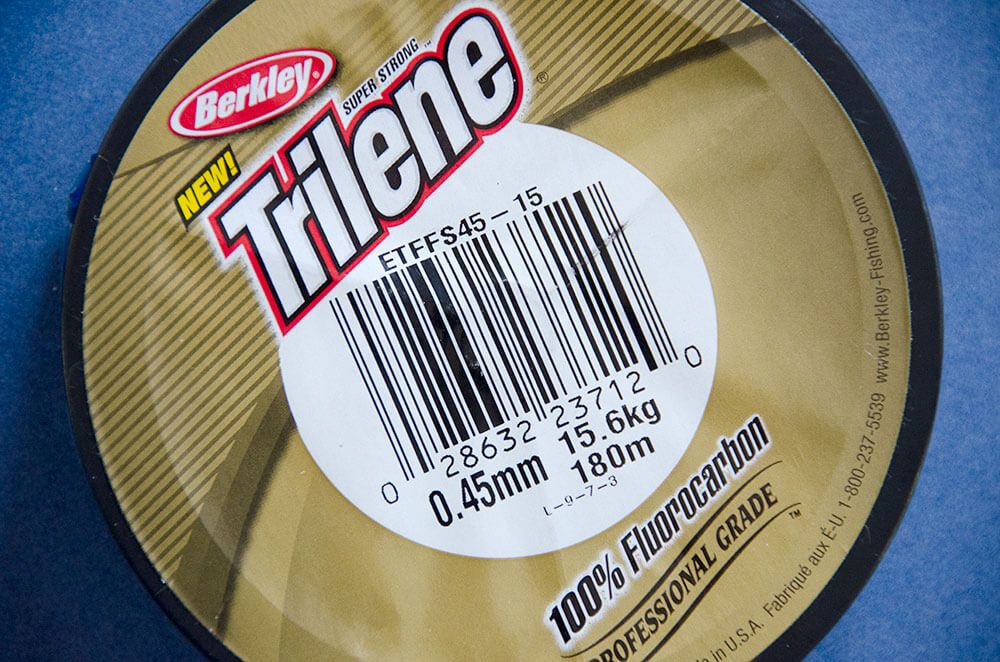
1 - Begin with 60-inches of 30lb Fluorocarbon or clear mono.
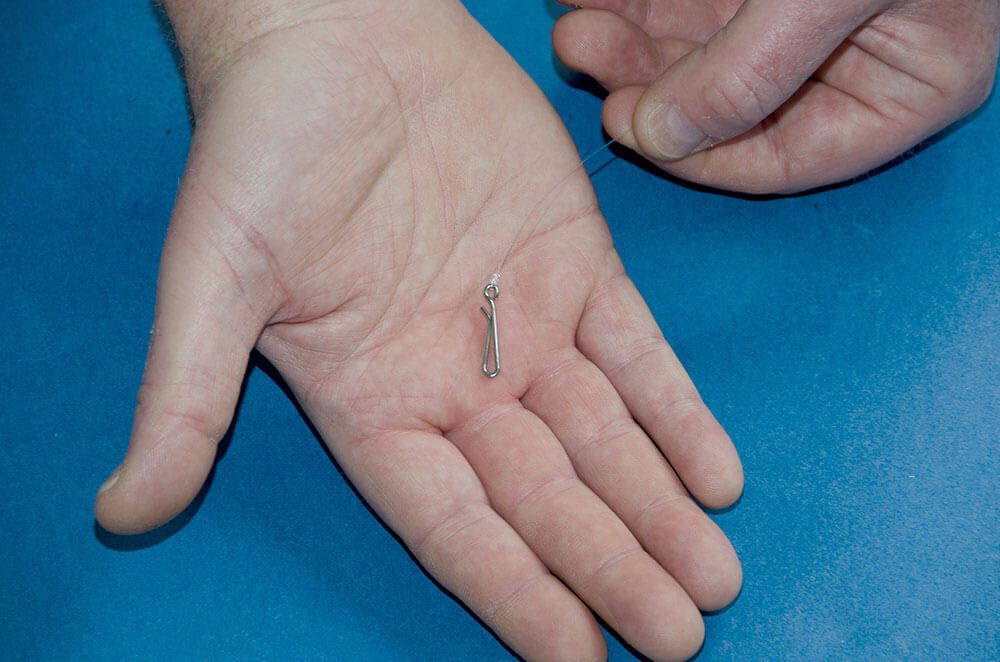
2 - At one end tie on a Gemini Lead Link.
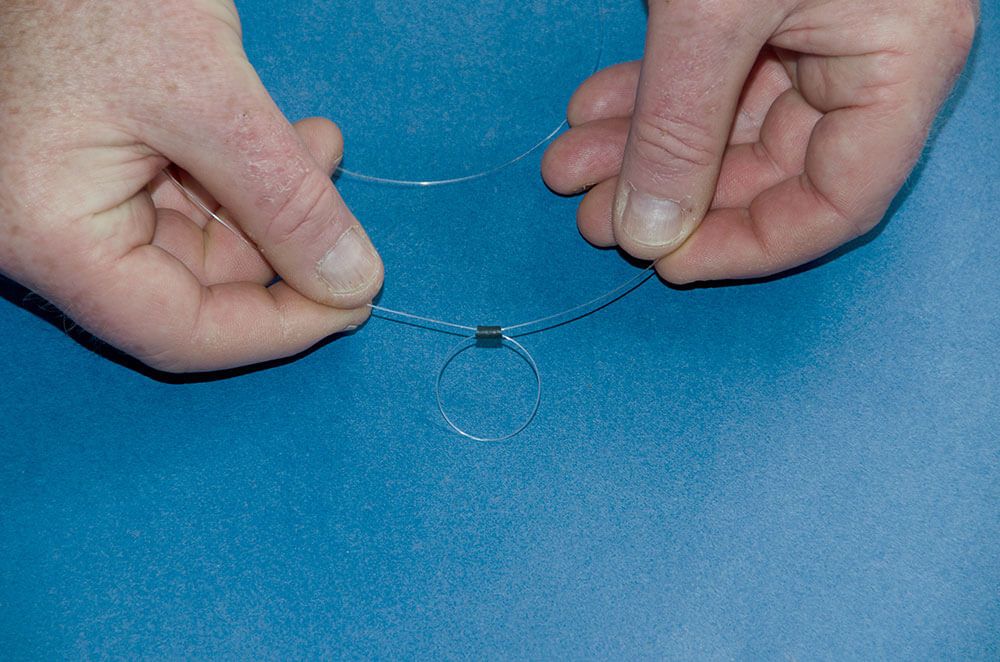
3 - Form a sliding stop knot using a short 4mm section of neoprene tubing passing the line through the tubing and bringing it back around and through the tubing the same way a second time. Now pull the line tight to lock the tubing in place.
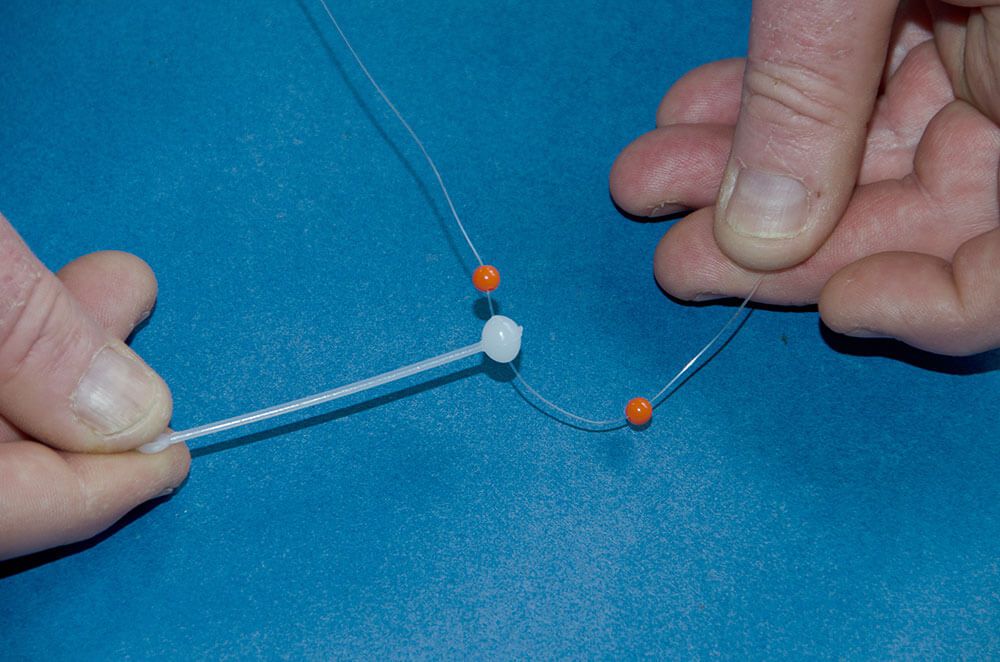
4 - Slide on a 5mm bead, an Avis type boom about 4-inches long, another 5mm bead and another neoprene tubing sliding stop.
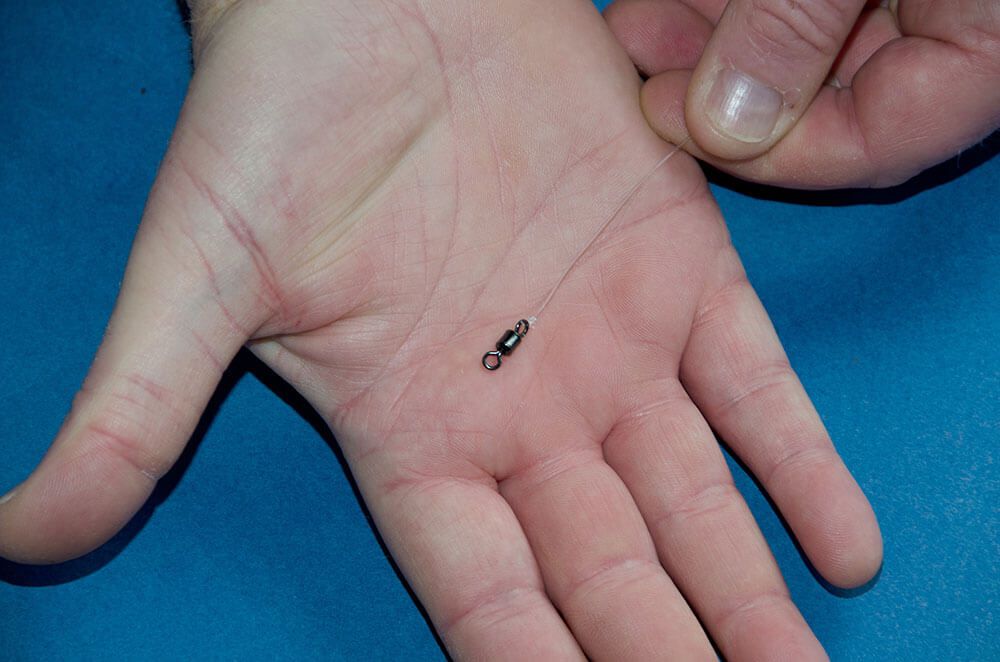
5 - Finish the main rig by tying on to the remaining free end of rig body line a size 6 rolling swivel.
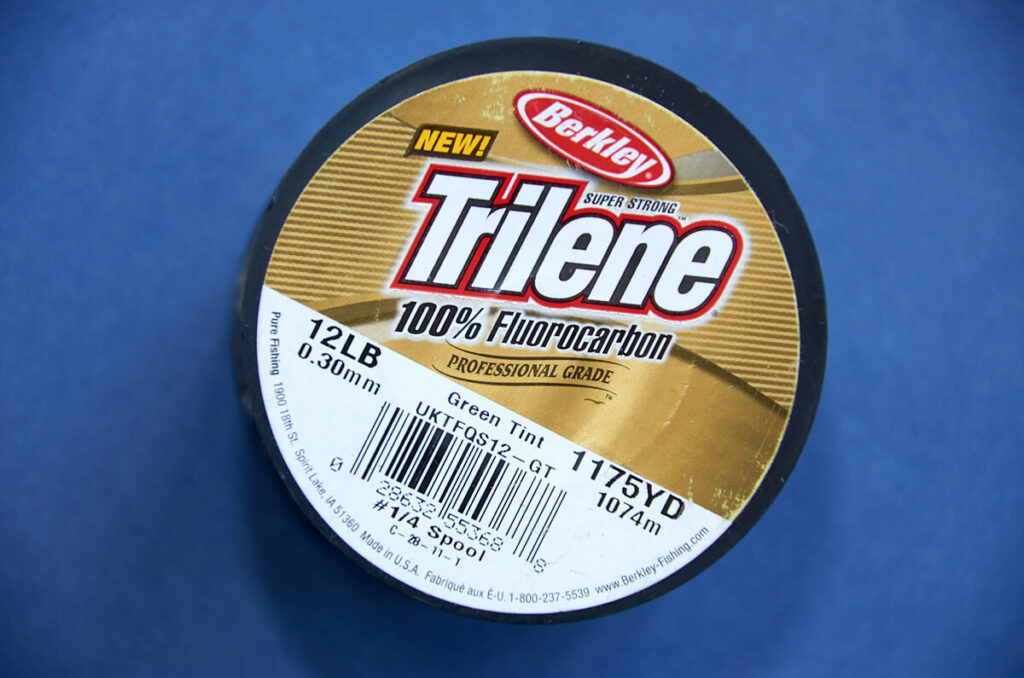
6 - The hook trace is 24 to 36-inches of 12 to 15lb fluorocarbon or clear mono.
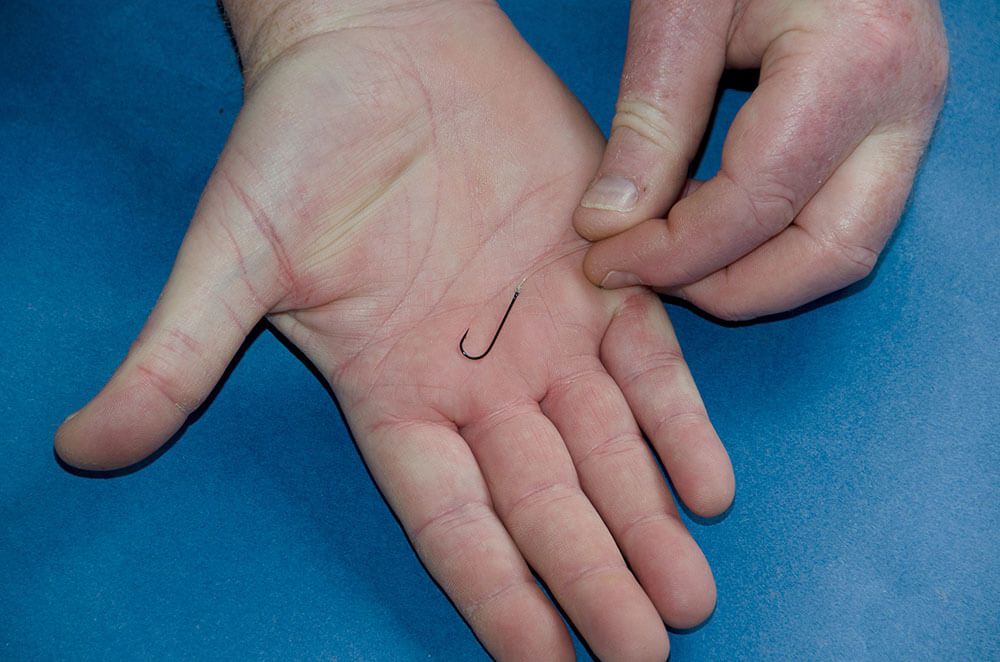
7 - Complete the hook trace with a size 4 to 6 Kamasan B940 Aberdeen or similar Sakuma or Mustad pattern hook.
By using the long length of rig body line, also the sliding stop knots, the boom can be positioned instantly tight behind the lead for fast tide conditions when the bream are hugging the seabed, but lifted up to a higher position when the tide slackens and the bream shoals are working higher up off the bottom.
The long flowing trace also adds movement to the bait and encourages more bites.
2-Hook rig
This is a good rig when the tide is slack or you want to target multiple fish, and also to have baits at different depths in the water column to cover as much depth as possible.
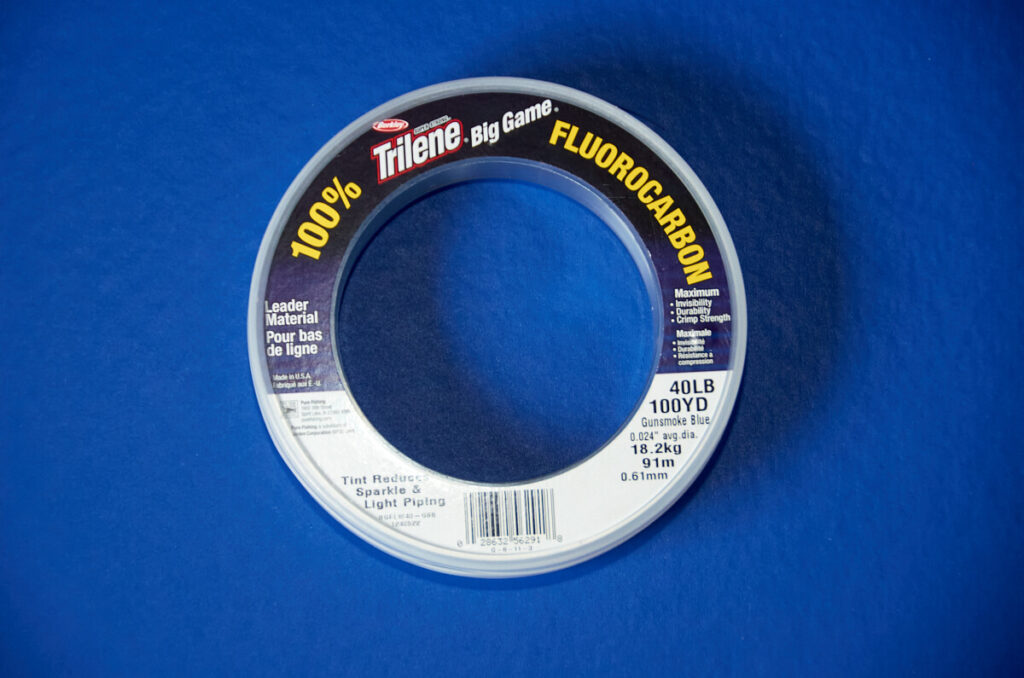
1 - Start with a 50-inches of 40lb fluorocarbon.

2 - At one end tie on a Gemini Clip Link.

3 - Form a sliding stop knot using a short 4mm section of neoprene tubing passing the line through the tubing and bringing it back around and through the tubing the same way a second time. Now pull the line tight to lock the tubing in place.
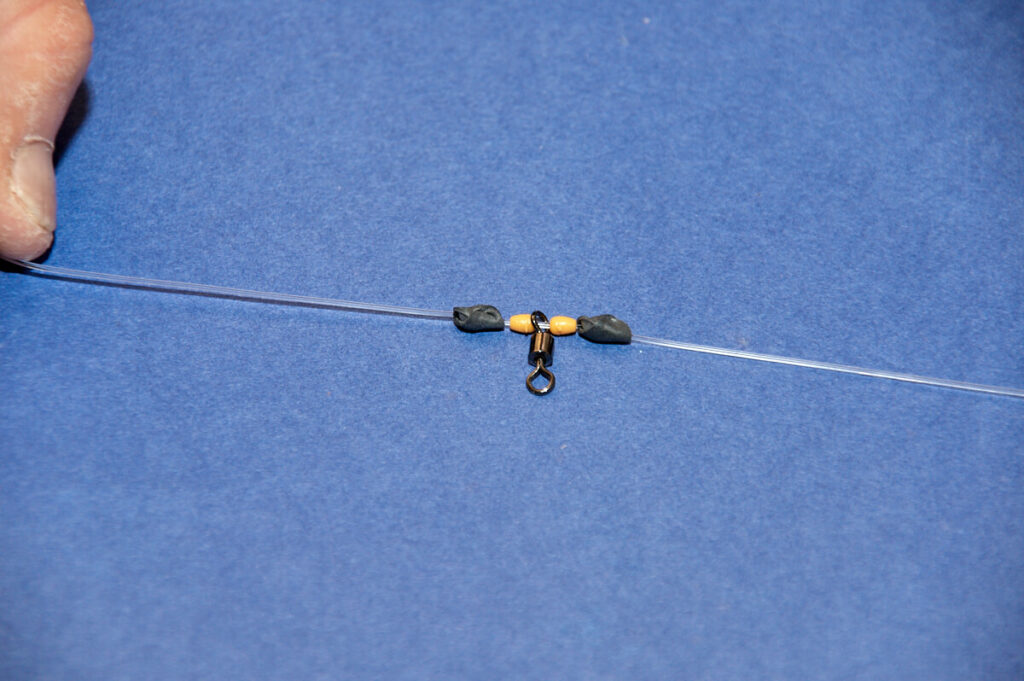
4 - Slide on a 3/5mm bead, a size 8 rolling swivel, another 3/5mm bead and another neoprene tubing sliding stop and lock the neoprene in place. Repeat steps 3 and 4 to form a second swivel bead and sliding stop sequence above the first.

5 - Finish the main rig by tying on to the remaining free end of rig body line a size 6 rolling swivel.

6 - The hook traces need to be 12 to 15-inches of 12 to 15lb fluorocarbon.

7 - Hooks should be Aberdeen patterns like the Kamasan B904 or similar, in sizes 6 to 2. Use 6 to 4 in shallow water, but 2 on the wrecks where you can expect bigger fish.
Using the sliding neoprene stops allows you to change the position of the hooks on the rig. A good starting point is to have the lower hook about 6-inches up from the lead link, with the second hook positioned about 30ins above the link. If all the bites are coming to the bottom hook, slide this down so it sits tight behind the link, and slide the top hook down to 22ins above the link. This puts two baits in the feeding zone and will increase your chances of bites. Also try the top hook as far as the rig connector swivel during slack water periods. Sometimes the bream will lift up in the water to intercept food items that are higher up in the water column.
Black bream have small but sharp teeth. The long shank Aberdeen pattern hook helps to reduce contact with the hook length which would be the case with a short shank pattern. This is also why the Talk Sea Fishing team recommends fluorocarbon for the hook length because it is a far harder material than mono is so it’s way better at resisting the abrasion from teeth. Also, the fluorocarbon is more difficult for the bream to see in shallow water and it will increase your catch rate.
Another little dodge we’ve found with black bream is that if the water is carrying a little suspended sediment and clarity is reduced, then the addition of one small 3mm luminous green bead directly above the hook can increase the catch rate. Just that hint if luminescence in the water is enough for the eagle-eyed bream to see it and come in to investigate. This helps them find the bait.
Another easy way to catch black bream is to use baited feathers. These need to be the feathers tied on smaller 2 to 1/0 hooks, or even the much smaller shrimp type rigs tied on size 6 hooks. Once baited, these put three baits very tight to the seabed and right in among the shoals of bream as they move across the reef ground.
Black bream are easy to please when it comes to baits. They will take mackerel and squid strips, mussel, cockle, small chunks of razorfish, small sections of sandeel, lugworm, ragworm, and are especially partial to chunks of prawn, even the cooked ones you get from supermarkets.
The knack when cutting strips of fish or squid, is to use either a very sharp knife, or better still a craft type knife with a very sharp blade, and cut the strips about 1 to 1.5-inches long and just a quarter inch to half-inch wide, no more. Also pair the flesh down a little so that the strip can move and wriggle more freely in the tide run. The best section to cut strips of mackerel from is the white belly section, as this imitates a small fish. Pass the hook once through from the flesh side and out through the skin. If you’re using squid, then use the same sizes. Squid is an exceptional bream bait and often selects the bigger fish.
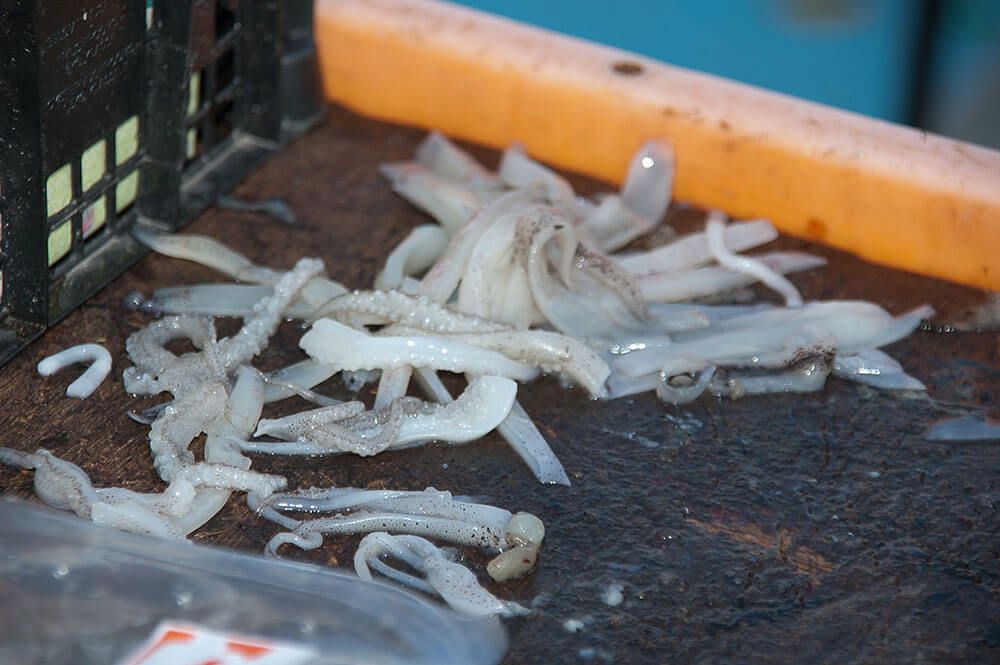
Other softer baits such as mussels may need a few turns of fine bait elastic wrapped over them to stop the small bream ripping the bait off the hook. Otherwise, it’s simply a case of just folding the bait over the hook shank two or three times to secure it.
Bream are ravenous feeders and don’t really need precise presentation. However, what is important is to not overload the hook. Bream have relatively small mouths so baits should only be big enough to fill the hook curve and the shank, no more, so they can easily take in the bait and hook. Make sure the hook point is fully free. Big bream will take in 4/0 hooks on the wrecks, but these are lucky fish that hit the right part of the bait by the hook point, but it’s not a valid tactic, even for the bigger fish.
Wreck fishing
The best wrecks are the ones that have blown up or broken in two as they went down. This often sees a wide field of scattered debris and it’s the debris that draws the bream in. These are the wrecks that hold the biggest numbers and often the better fish. If the wreck is virtually whole, with little in the way of debris, then fishing will be far less successful.
Smaller inshore wrecks can be fished the same, but sometimes, due to lack of tide run, you may need to anchor just up from the wreck and cast baits down into it to get the best of the fishing. Use either the 8ft 6in boat rod and a fixed spool reel for ease of casting, or use a longer soft tip type rod with a very supple tip and around 11ft in length to get that extra distance and bite detection.
As we’ve mentioned, the boat skipper will anchor uptide of the wreck and gradually let anchor rope out until the boat is a little way from the wreck. To fish the wreck correctly, you need to judge the weight you use so that it is just enough to be able to be bounced down a few feet at a time in the tide by lifting the rod tip and letting a little line go off the reel. This allows you to gauge roughly where the wreck is and let your baits fish down and even on to the edge of the wreck where the bream will be feeding. You’ll know when you’re tight to the wrecks because you get regular bites.
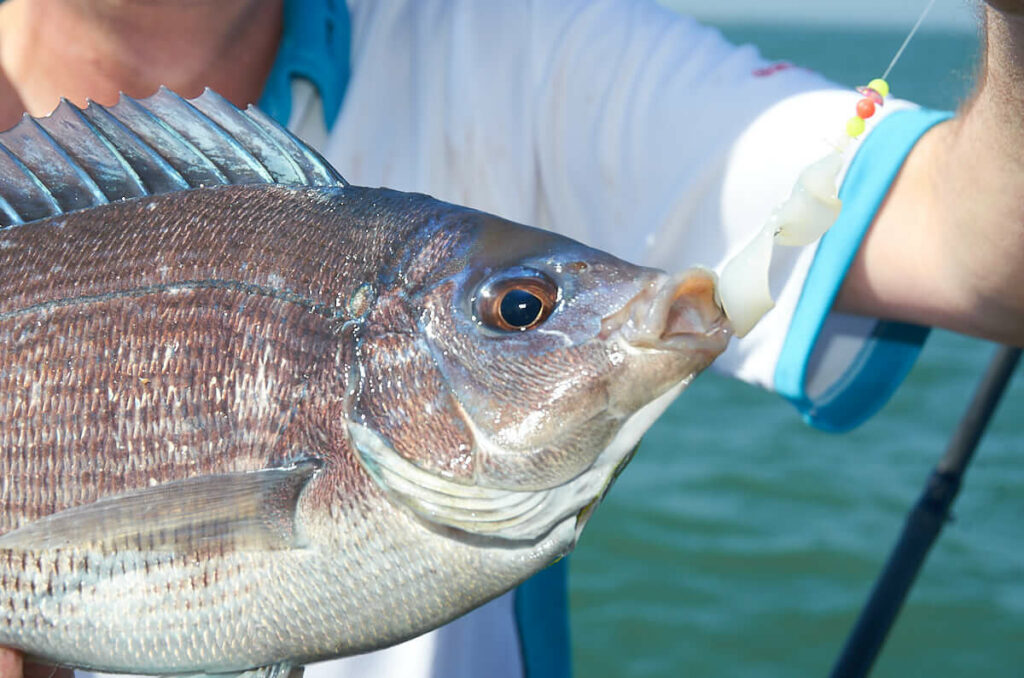
When you get a bite and hook up, try to get the fish away from the wreck and up in the water as soon as possible. This gets them well away from potential snags. Once up in the water column you can relax and enjoy the fight.
Bream bites are a series of very fast rattles and you need to react fairly quickly to these by lifting the rod tip to strike. This tells you, you need to keep a tight line to the lead weight all the time. Bream are notorious at hammering the rod tip down yet missing the hook. This is usually smaller fish ripping at the baits but not having the hook in their mouth. Try reducing the bait and hook size when this happens and you’ll catch more fish. Bigger fish are more likely just to pull the rod tip right over without prior warning. These fish rarely need striking.
Bream use their power and body shape to try and power down. On the rod tip this feels like a series of jabs or fast dips of the rod tip. The bigger fish will take line easily and make small runs of a few feet or yards. They will fight right to the boat, so it’s best whether charter boat or dinghy fishing to have a net ready and net the bigger fish.
Reef fishing
Reef is a loose term when it comes to black bream. It can describe a deep water reef that has boundaries of sand, a large or small patch of rougher ground, and inshore shallows where rough ground dominates. In all cases though, you are looking for areas where the ground feature rises from the general seabed level. The bream will tend to congregate in areas where the ground feature rises off the seabed, these being obvious rocky pinnacles, areas of larger boulders, or even just a couple of bigger than average stones. They will also be attracted to shelves of rocks or shelving wall-like features.
Freshly laid lobster pots, due to the scent of the pot bait, will also concentrate the bream. Also keep in mind that the potters tend to lay their pots where there is rising feature on the seabed. The lobsters need the feature to find hidey holes to live in, and this can be a quick indicator to help you locate the sort of ground you need to find the bream. It goes without saying, be respectful to the potter and keep a sensible distance away from his ropes and creels. The scent of your fresh baits will pull the bream away from the creels, anyway.
Other things to look out for are kelp weed beds which the bream love to work near and through, and in shallower water, we’ve already mentioned eel-grass beds which are typical bream grounds in shallow waters.
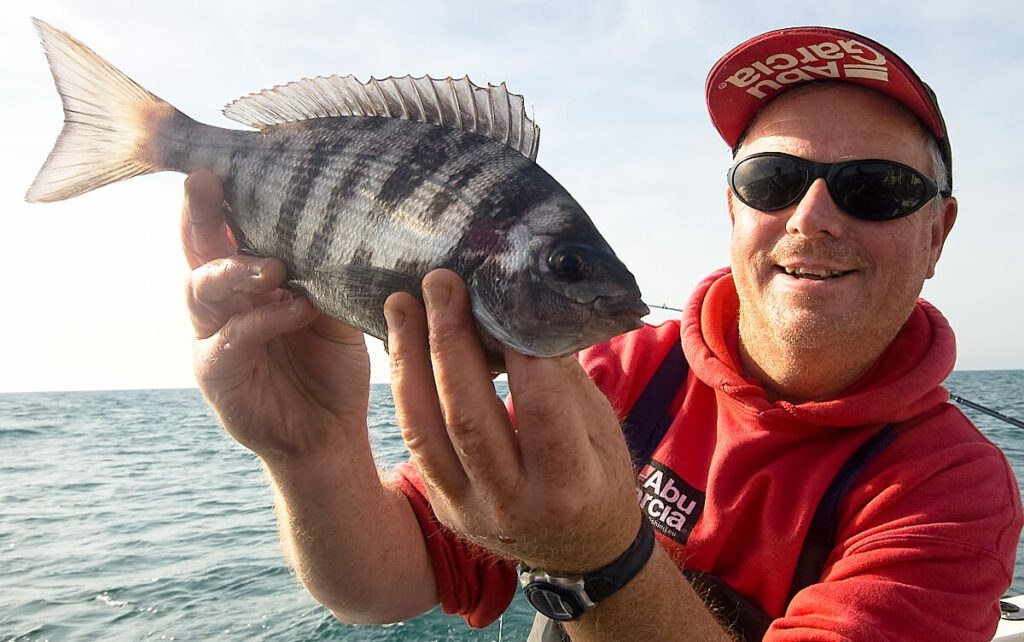
You can often see ground features especially in shallower water, by looking for surface disturbance such as boiling water, roughened surface water or small waves in a tight area. This is caused by the tide flowing over the ground feature and the upwelling water being forced to the surface. The surface show will be downtide of the actual feature, but it’s an excellent way of finding feature then fully exploring it until you find the fish.
From here on it’s much the same as fishing the wrecks. Anchor the boat so that it sits close to but uptide of the feature, then bounce the baits down to the fish. Slowly but surely, as the bait's scent works down tide, the bream shoals will swim uptide towards you and then concentrate in an area where you can catch them consistently off the stern of the boat.
In the shallower water, this is an ideal opportunity to fish the lighter tackle described in the tackle section. Fishing as light as is sensible increases the bite detection and you can fish a very light lead, sometimes as light as an ounce, and really work the ground downtide of you. By doing this, if you take notice, you’ll discover little spots that have either more bream on them, or bigger fish present.
Some skippers and dinghy crews put rubby dubby down with the anchor so that this flows down below the boat and brings in the bream faster, plus holds them longer. This need only be minced up mackerel and bran with a little pilchard oil, or add in a couple of tins of tuna in sunflower oil or pilchards in sunflower oil. This needs to be put in a plastic container with small holes drilled in the body and sides. You’re looking for a slow but consistent release of scent, not a sudden explosion. The container you use needs to be a solid type as if you use onion bags or something light and flimsy, often a tope will come along and rip it to sheds so that there is no dubby left. Equally, the teeth of the bream will quickly shred an onion bag into big holes and again the effect of the dubby to hold the fish is lost.
It’s worth a few lines on shore fishing for bream. There are not many areas outside the English Channel where you can catch bream consistently off the shore. The best areas are from Sussex down through Hampshire and into Dorset. Chesil Beach is one such place where good fishing can be had for bream. They tend to be best concentrated around small inshore wreckage from WW2 and also patches of rougher ground.
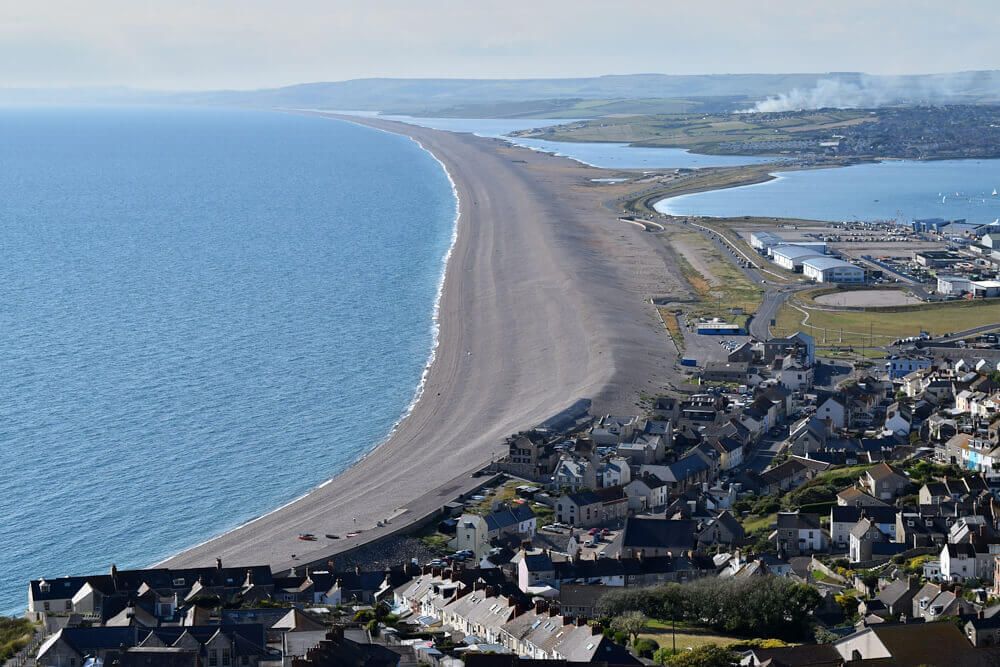
The Isle of Wight has good beach marks for bream, as does the Channel Islands, especially Alderney and Guernsey. Anywhere that sees you casting onto rough ground is a good place to try, also try rough ground off breakwaters, with Alderney Breakwater being one of the best examples.
There are beach marks that see bream caught in mid Wales, and also in Morecambe Bay, but the fishing is not consistent. Here, the water is shallow generally, so look for eel-grass beds and shallow inshore reefs for the best opportunities.
Regards their preferred habitat, again look for areas among the rough ground where rising pinnacles come up, or areas where there are concentrations of bigger boulders. Kelp beds are good, as are ridges of rock that force the tide to flow over them and these can often be seen on the surface water again during the flooding tide. These can often be found simply by losing the odd bit of tackle to locate where the rougher areas are.
If there are cliff paths high above where you might fish, then use the height to see down into the water to help you see exactly where rough ground begins and ends. Even shallow inshore marks often have some elevated sand dunes or cliffs you can use to gain that little bit more knowledge of where the most productive ground might be. Height also lets you see the eelgrass weed beds, too.
It’s likely that tackle will be dictated by the distance needed to cast. On rocks ledges then less distance maybe needed but the ground will still require a normal 4 to 6oz beachcaster, Penn 525 sized multiplier and line of 20lbs breaking strain with a 60lb shock leader. A 2-hook clipped down rig is a good choice as again it offers two baits close together to increase the scent trail, plus you’ll get the chance to catch two bream at a time, and select which bait is working best on the day.
The alternative would be a longer European style rod, bigger 7500 sized fixed spool reel loaded with 30lb braid and finishing with an 80lb braid leader. This will cast to maximum range and still give great bite detection.
The same 4-6oz beachcaster or the Euro style rod is recommended for shallower water, but here you may be able to get away with a lighter 2-4oz bass rod and a small 6500 sized multiplier loaded with 15lb line and a 30lb shock leader.
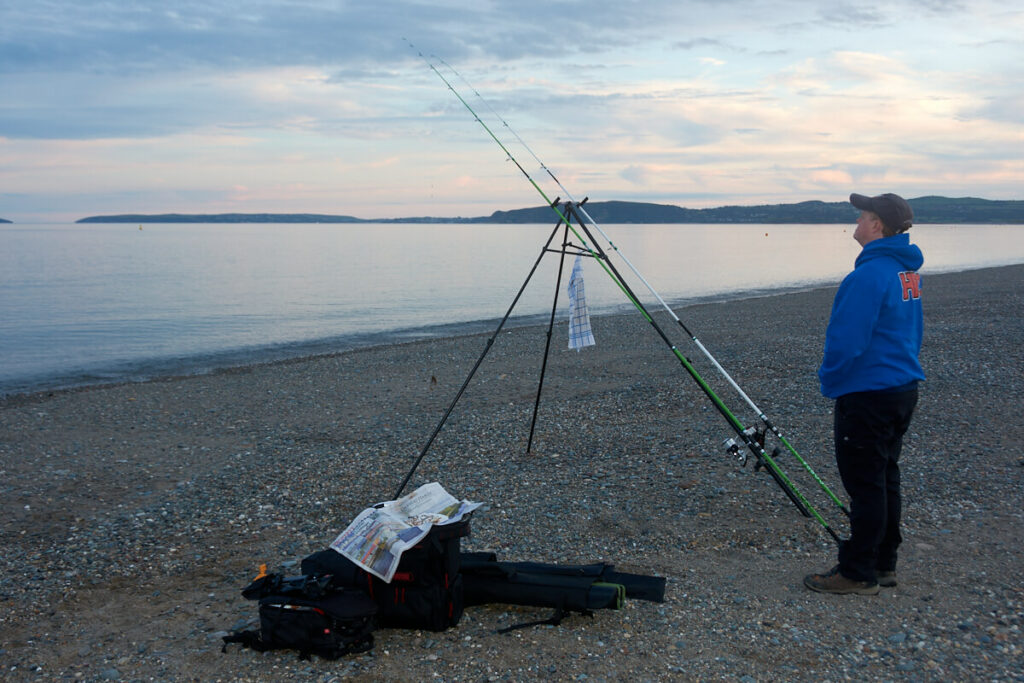
A good rig for the eel-grass beds and lighter rough ground in shallower water is the 2-hook boom rig. The booms mean there are less tangles, bait presentation is good, plus the baits are kept well separated. Here’s how to build it.
2 hook boom rig
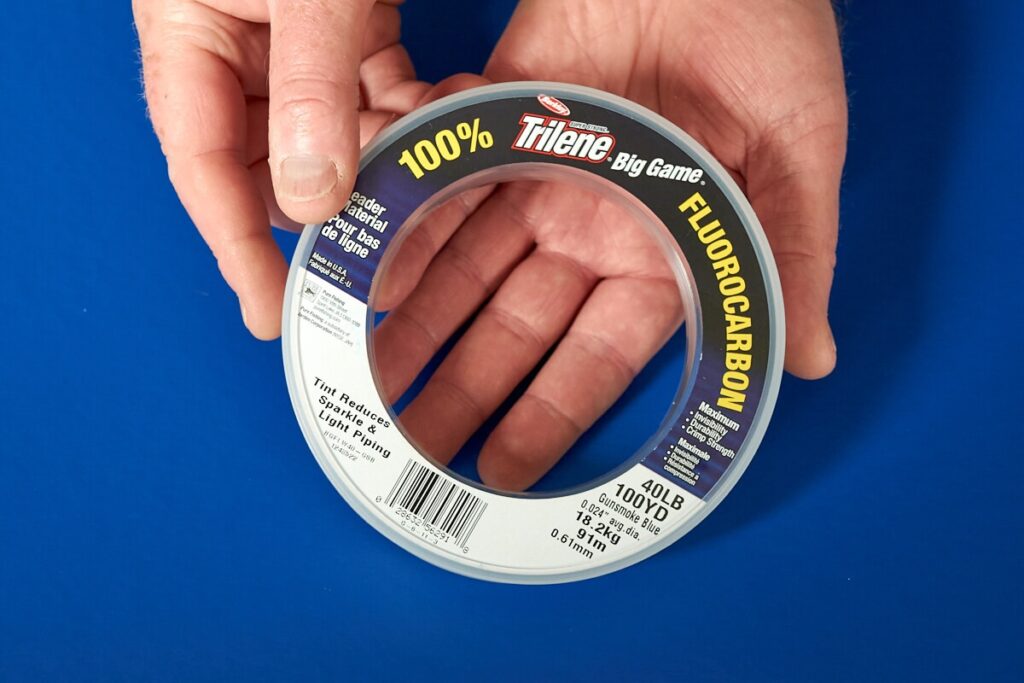
1 - Begin with at least 44-inches of 60lb clear mono.

2 - To one end tie on a Gemini Lead Clip
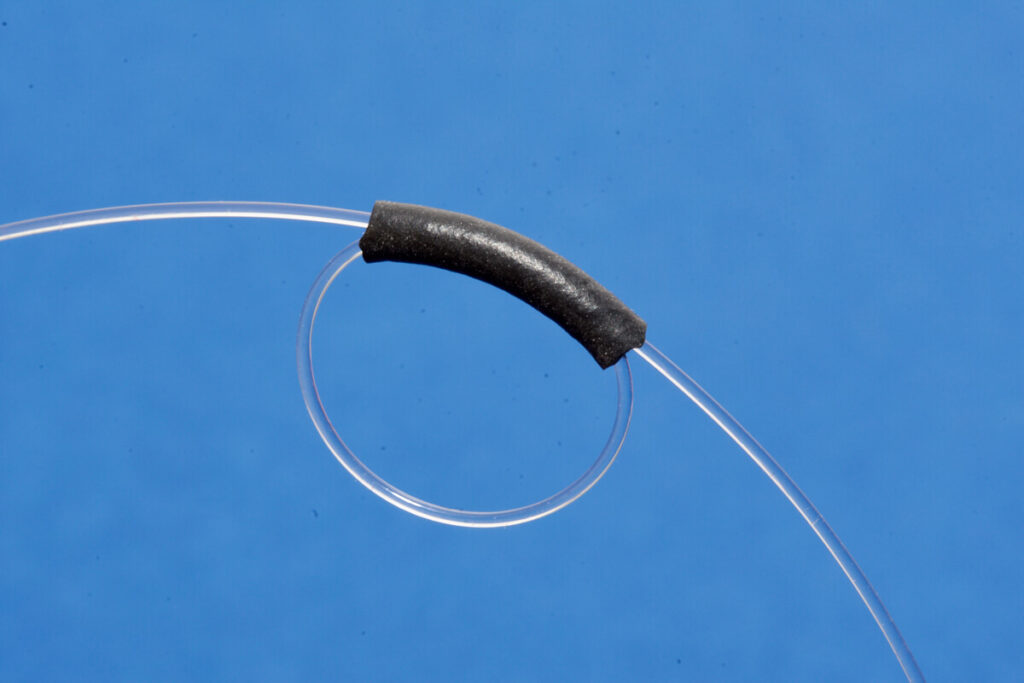
3 - Slide on a 5mm length of neoprene tubing, pass the line through the tubing, back over on itself and back through the tubing the same way. Now pull the line tight to lock on the tubing. This forms a sliding stop.
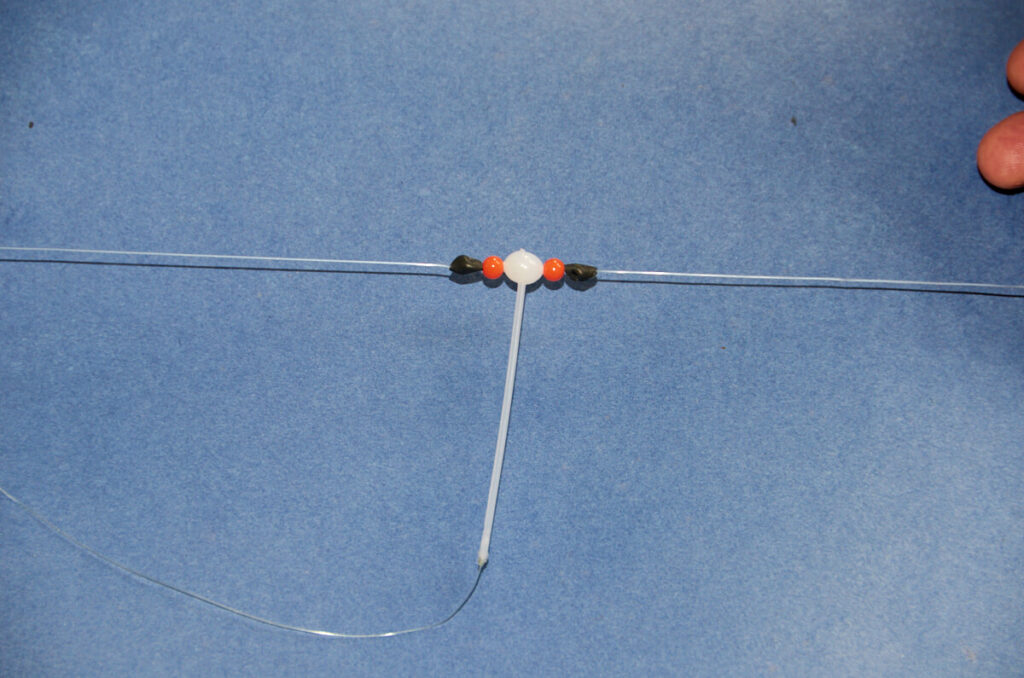
4 - Slide on a 3mm rig bead, a stiff 3 to 4-inch plastic boom, and another rig bead. Slide on another 5mm section of neoprene tubing, then tighten the line to form a second sliding stop.
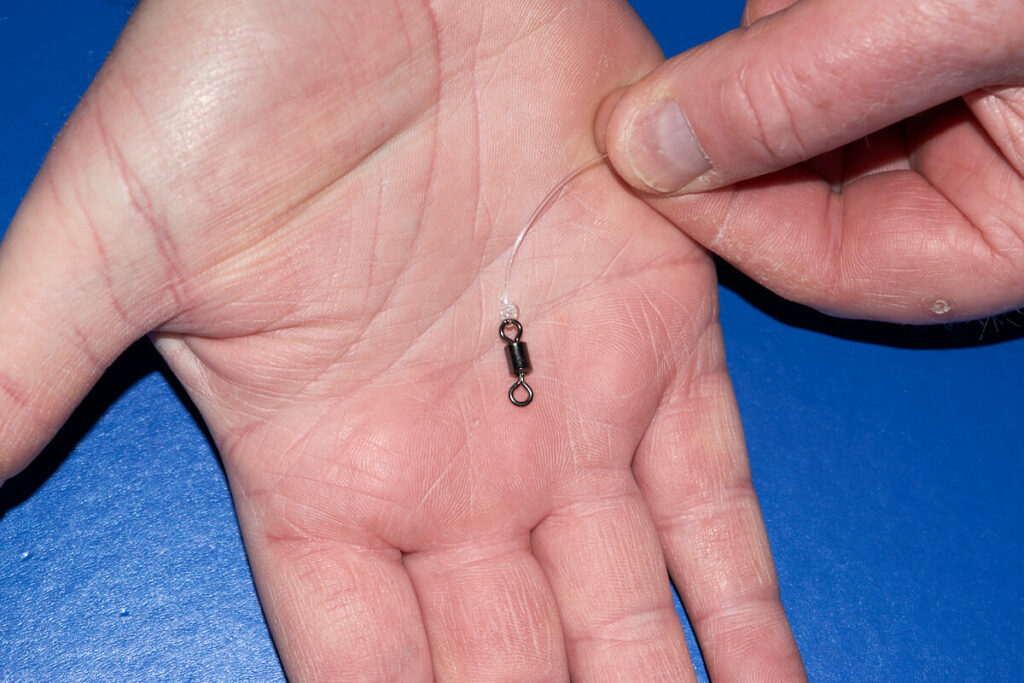
6 - Slide on a rig crimp, 3mm bead, another boom, another rig bead and a crimp. To the free end of 60lb mono tie on a size 6 rolling swivel.
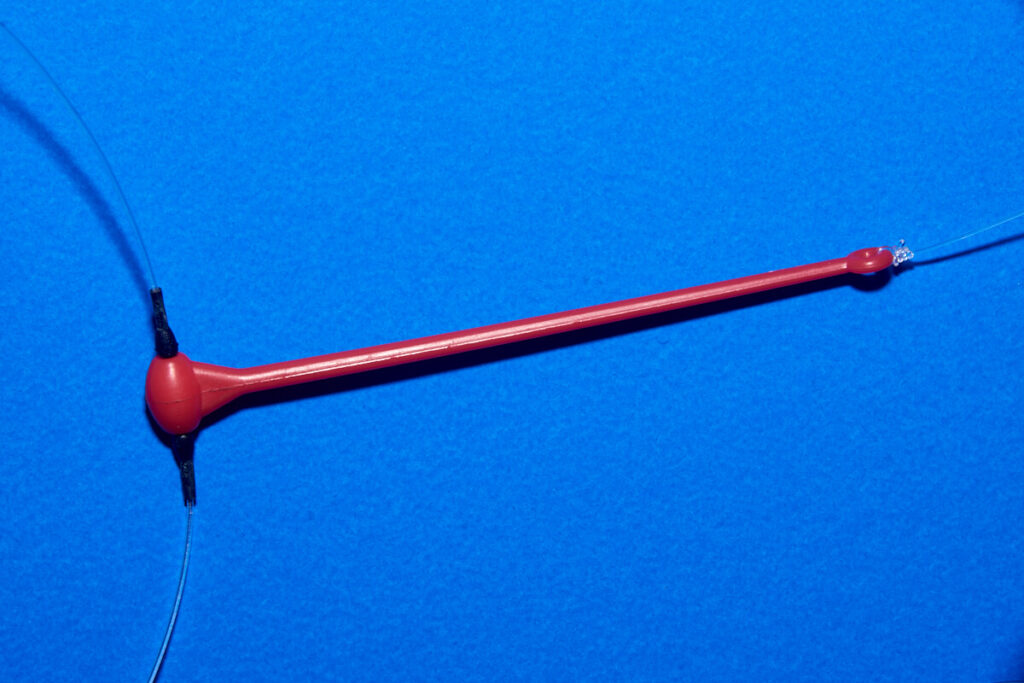
7 - Crimp the top boom in place 3-inches below the rig connector swivel.
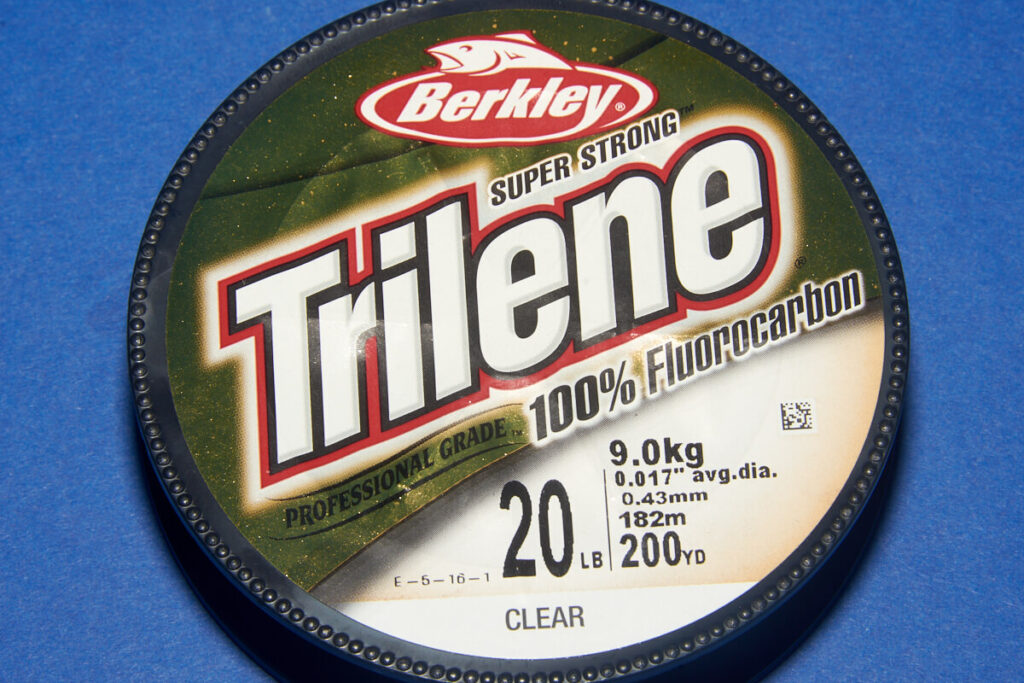
8 - The lower boom requires a hook trace 15-inches long. The top hook trace is longer at 20-inches long and from 20lb fluorocarbon.
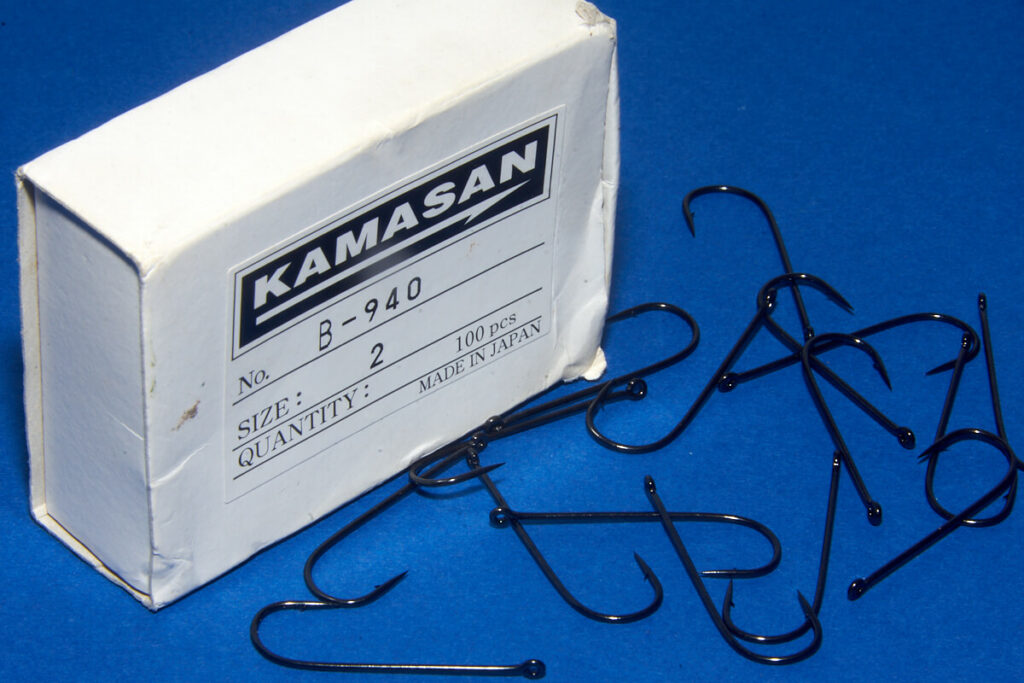
10 - Finish the hook length by tying on a size 6 or 4 Kamasan B940 Aberdeen hook.
Positioning the lower hook tight behind the link gives you one bait on the seabed, but the longer top hook link will move more in the tide, so you’re covering both fish working tight to the ground, and also those swimming up above it.
2 hook clipped up rig
For longer range casting a 2-hook clipped up rig is far better and maximises both casting distance and bait presentation at range. Build as follows....
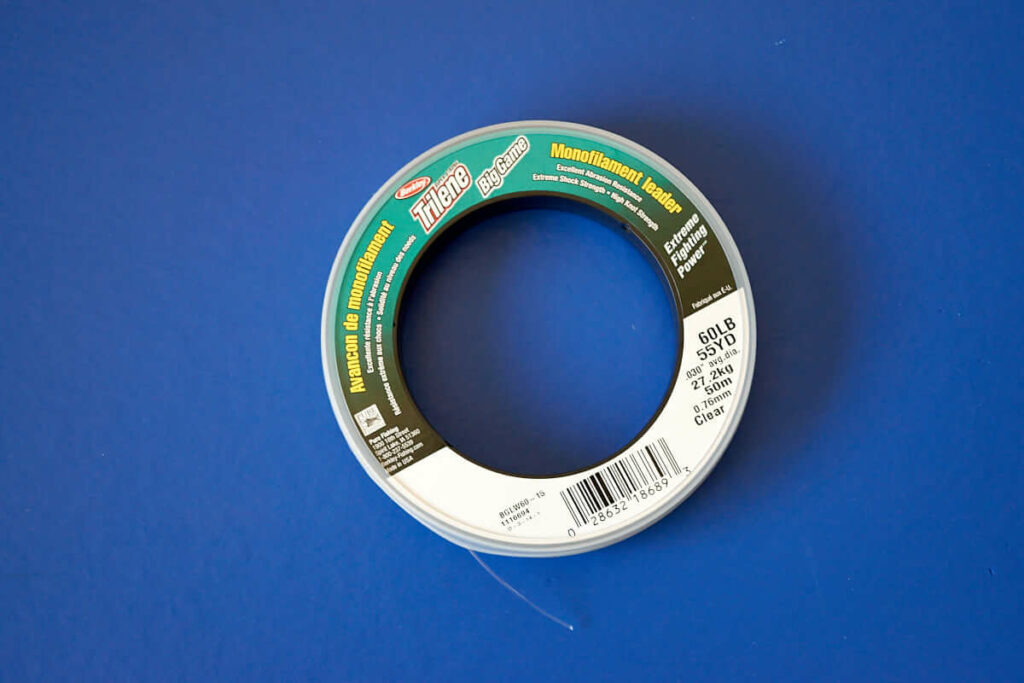
1 - Take a 46-inch length of 60lb rig body line. At one end tie on a Gemini lead link.
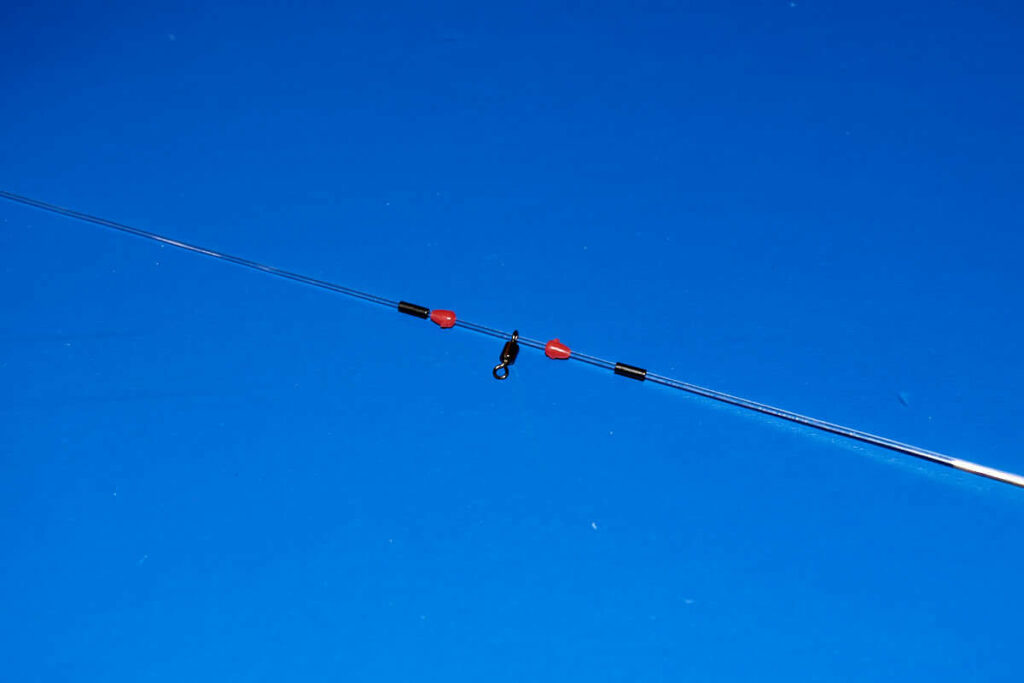
2 - Slide on a rig crimp, followed by a 3mm rig bead, a size 10 rolling swivel, and another bead and crimp.
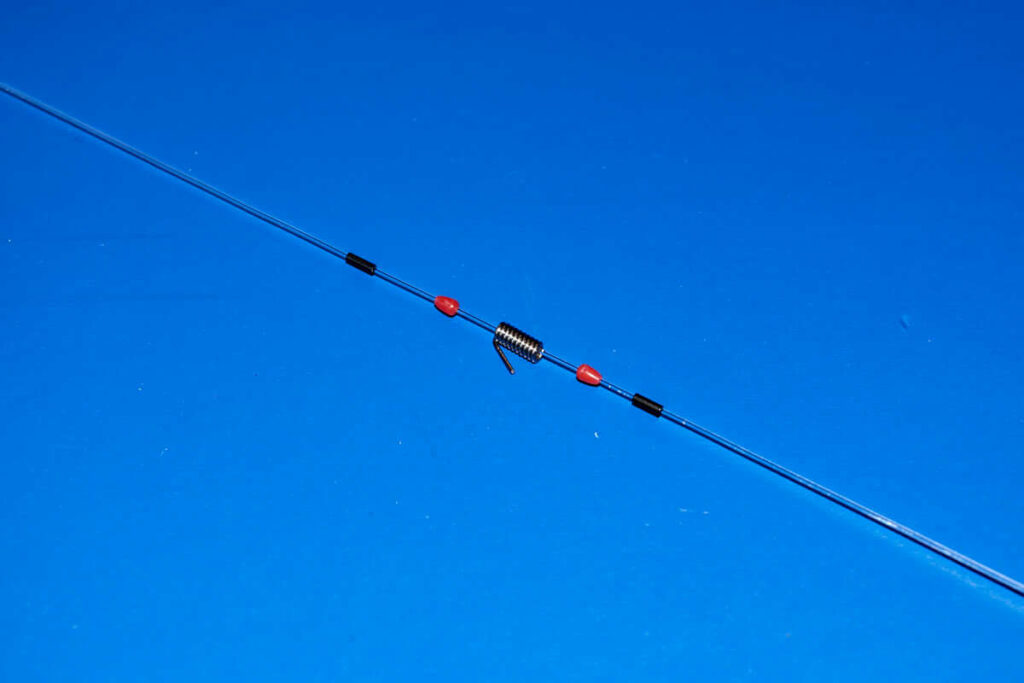
3 - Above these add another crimp, a rig bead and an inverted SALT bait clip, then a rig bead and another crimp.
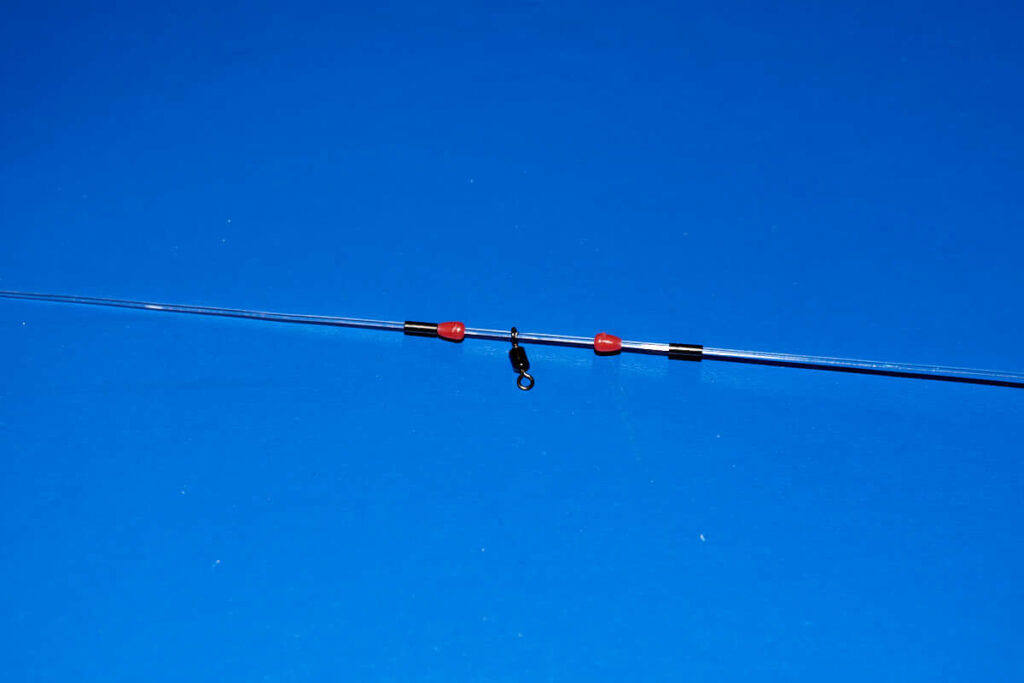
4 - Slide on a rig crimp, followed by a 3mm rig bead, a size 10 rolling swivel, and another bead and crimp.
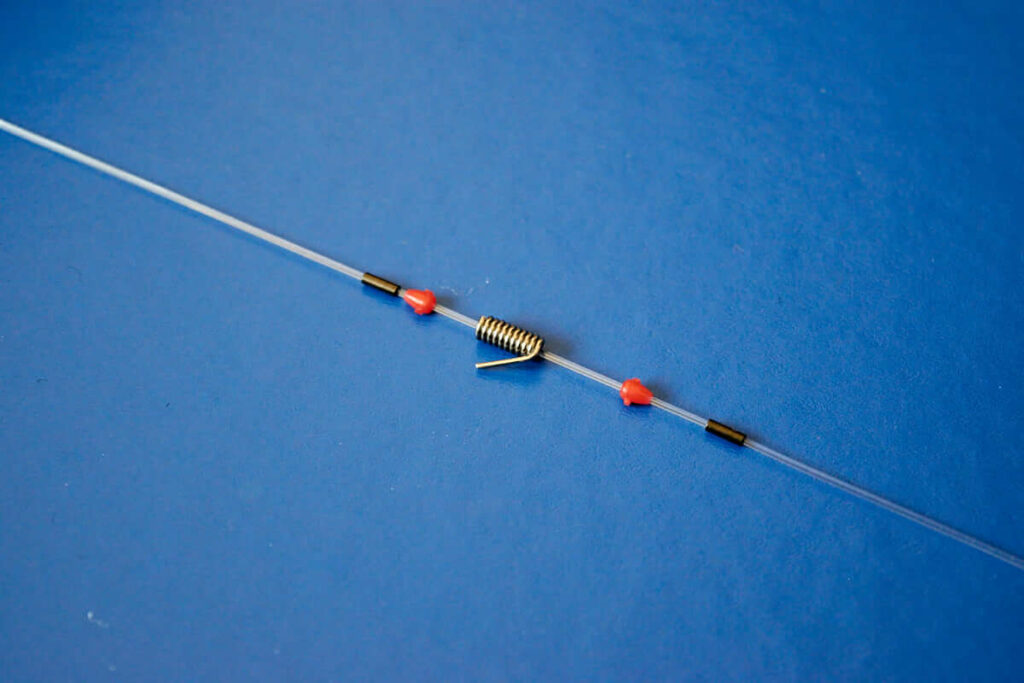
5 - Slide on a crimp, bead and inverted SALT bait clip, plus another bead and crimp. Leave all the above components free to slide on the rig body line for the moment.
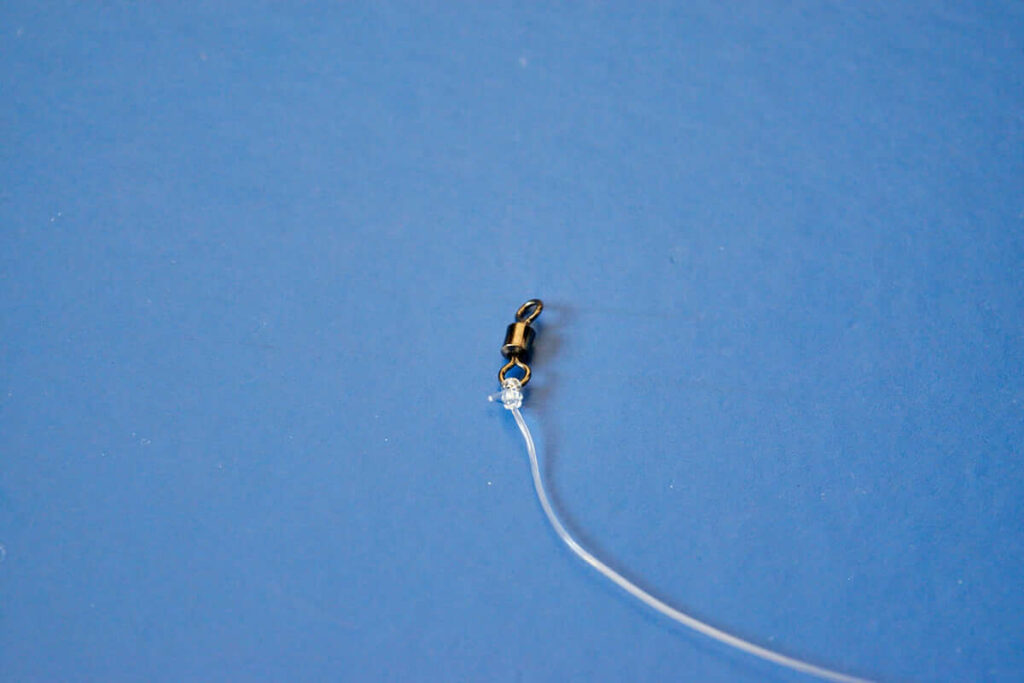
6 - Complete the main rig by adding a size 4 rolling swivel at the top.
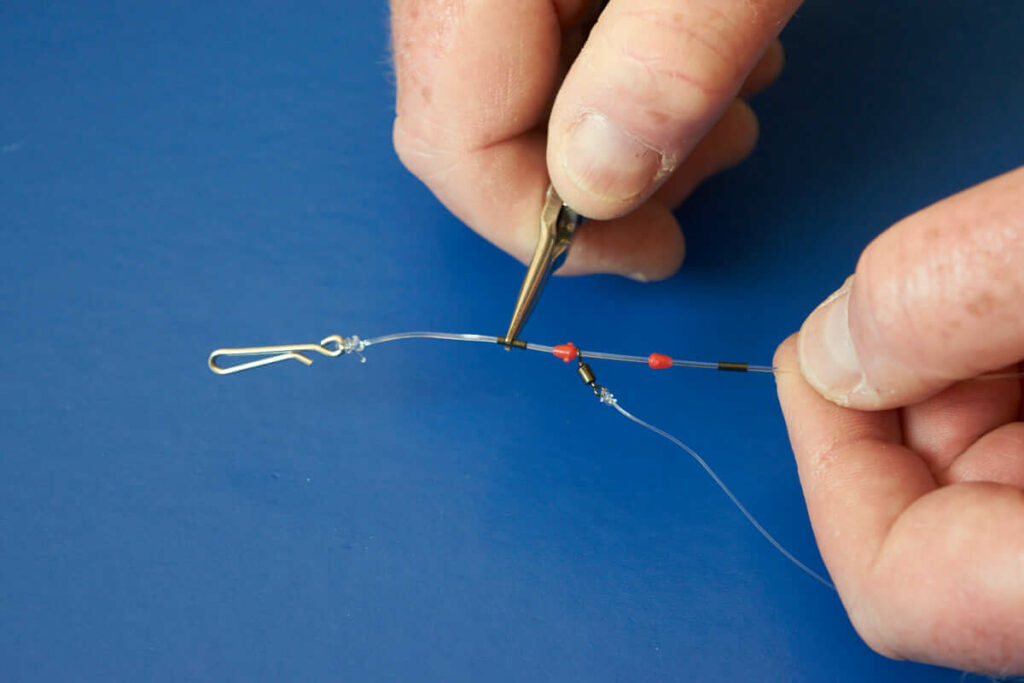
7 - Now crimp the first snood swivel in place 1-inch above the lead link. Leave enough room between the two crimps and beads for the swivel to freely turn.
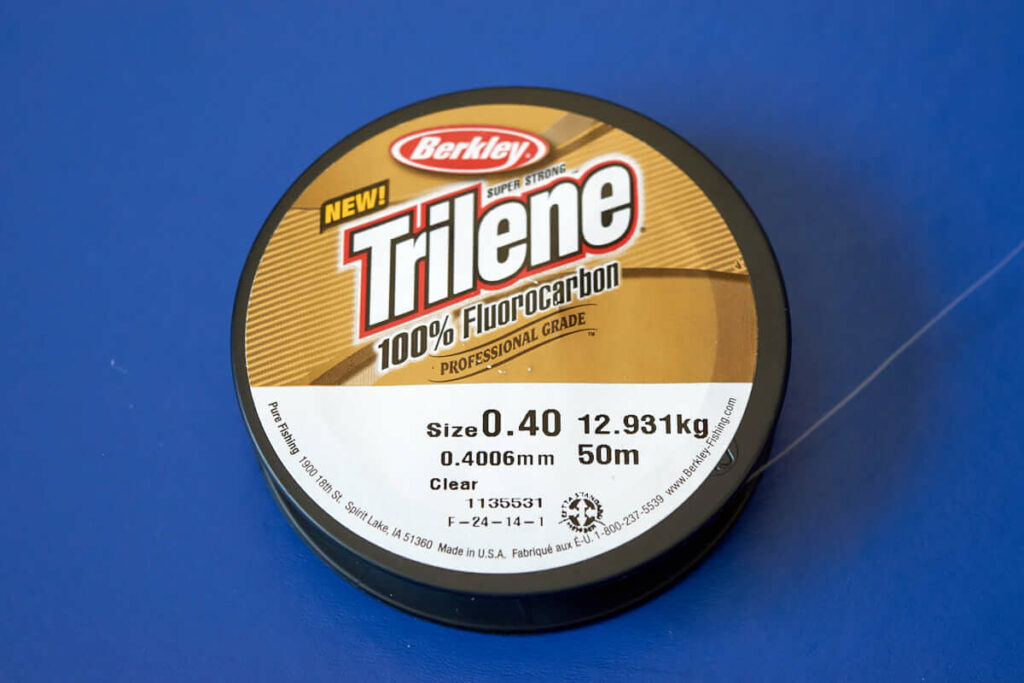
8 - The hook links need to be 15/20lb mono or Fluorocarbon between 12 and 18 inches long.
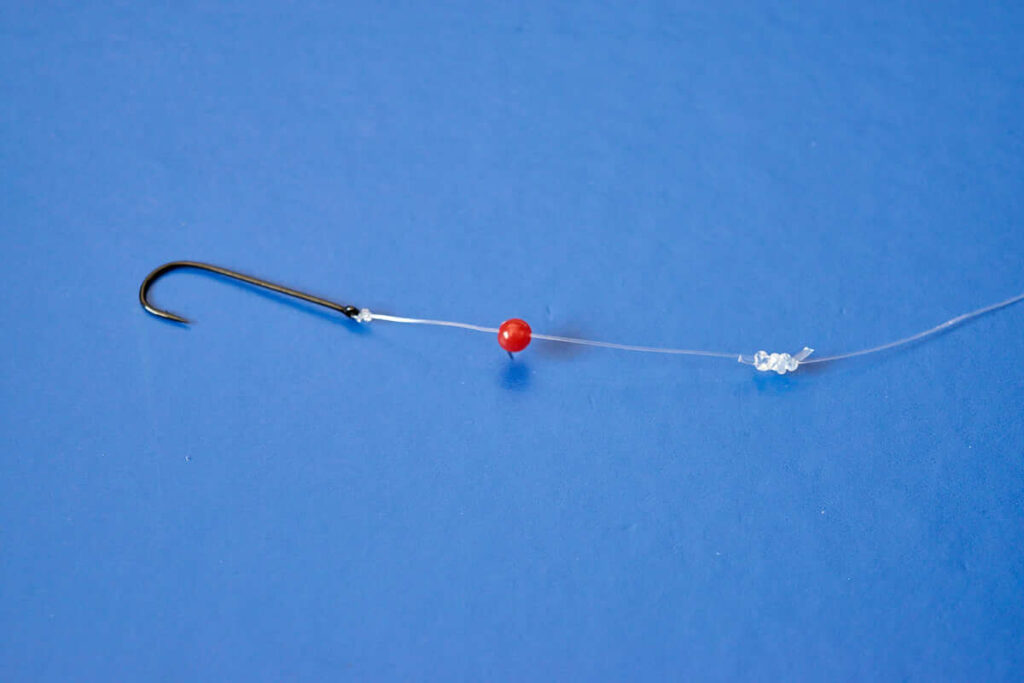
9 - Slide on a 5mm rig bead to act as a bait stop, and tie on a size 4 Kamasan B940 Aberdeen hook. Above the 5mm bead tie in a 4-turn Powergum stop knot.
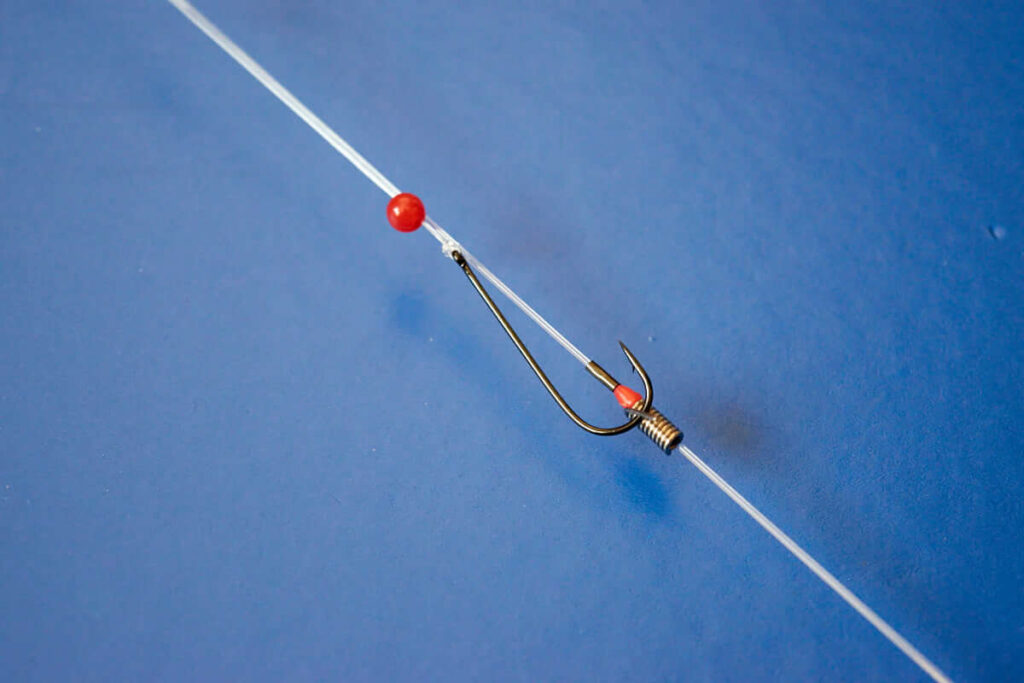
10 - Position the hook in the bait clip and slide the bait clip up the rig until the hook snood comes just tight. Slide the crimp and bead up towards the bait clip and crimp it in place half an inch below the bait clip to allow the clip to slide a little under pressure.
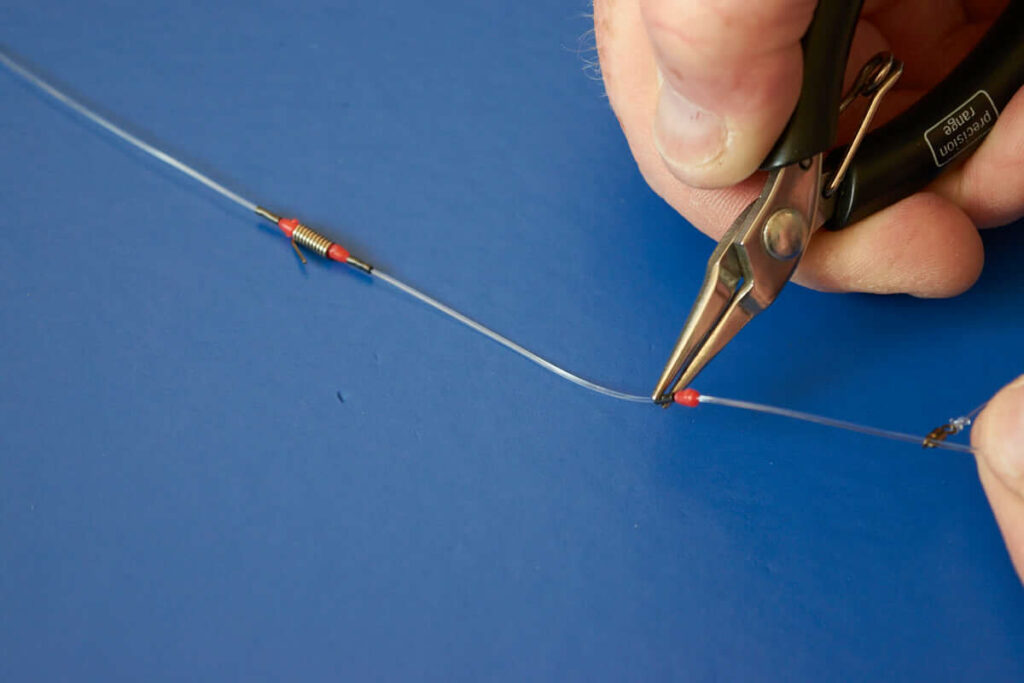
11 - The second snood swivel needs crimping about 3-inches above the first bait clip. Add the hook length and hook with the bead and hook, plus Powergum stop-knot added.
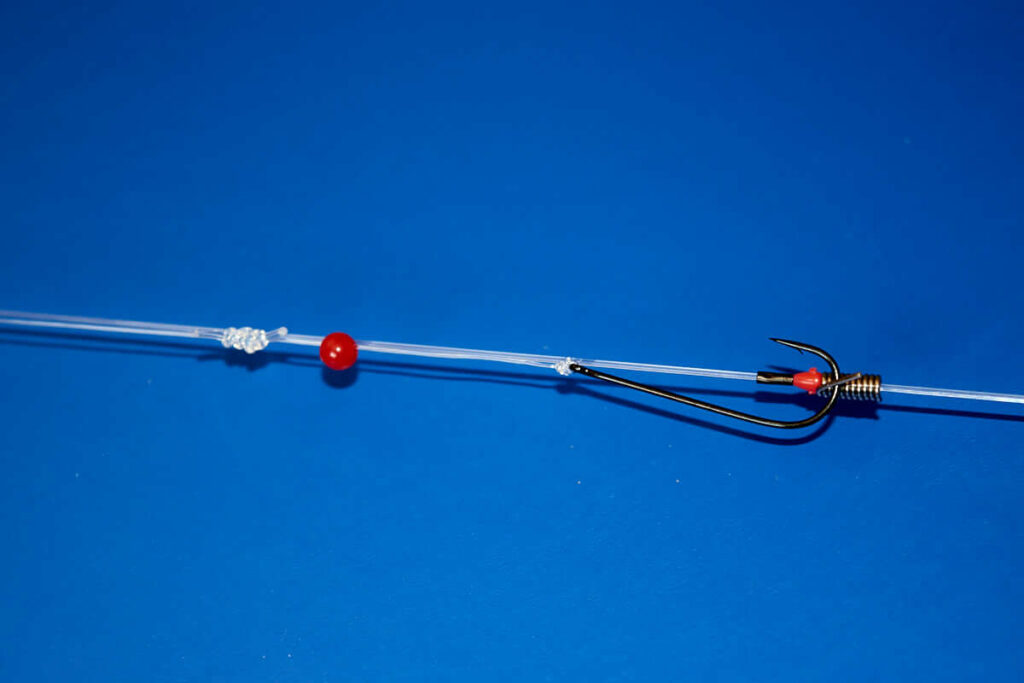
12 - Position the bait clip and crimp in place as before. This positions the top hook inside the bait clip just a couple of inches or so below the main size 4 connector swivel.
Baits are the same as described in the boat fishing section, though small peeler crab baits on inshore rough ground can work very well and will often pick out the bigger bream.
Black bream tend to show from the inshore shallow ground as the tide starts to really pick up and flow strong, so expect the middle hours of the flood and up to high water to be the best on most marks. The increasing depth of water is also important as the deeper it is the more secure the bream feel and are therefore more inclined to feed. You’ll find that once the ebb starts to flow strongly the bream will move off into deeper water. This especially applies on the bright sunny days.
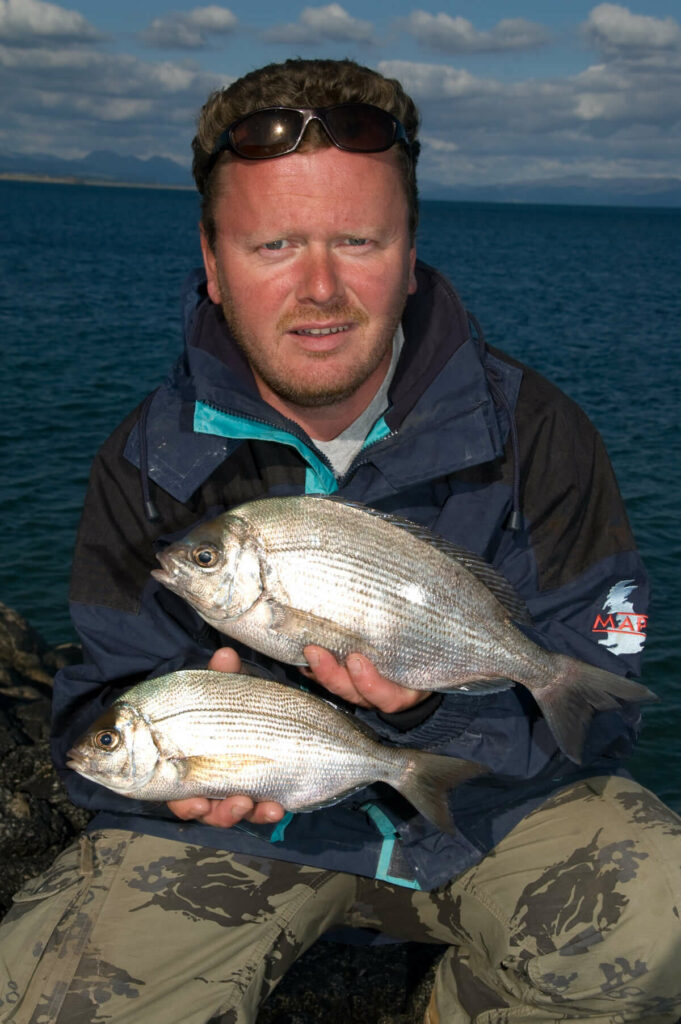
Ideal conditions are a light onshore wind that ruffles up the surface and cuts down on the amount of light entering the water column. Lightly overcast days are good, but low cloud and mist never seem to fish well for bream, for some reason.
If you fish two rods side by side and at different casting distances, also with different baits on each hook, you’ll quickly identify exactly where the bream are regarding distance and also what their bait preference is. This is a good way of combining the two rods in a seek and search pattern to make the most of the time the bream are in front of you.
About the black bream
A summer visitor to UK and Irish waters, black bream are noted for their hard fighting abilities on appropriately light tackle, plus it’s rated as one of the very best fish to eat. In fact, black bream were a favourite on the menu during Roman times, this has been proven by their bones having been found in excavated rubbish pits during archaeological digs in the southern half of the UK.
Anglers find it annoying, but they are often referred to as “sea bream” by chefs trying to avoid any connection with freshwater bream.
Identifying Black Bream
Black bream are pretty easy to identify. They are oval with a small, angled at the front, head. The jaw junction extends only as far as the front line of the eye or slightly less so. It has small pointed teeth.
Its overall colouration depends on the depth at which it is living. In shallower water the fish is mostly silver with a slightly bluish tinge to the back. In younger fish there may be a series of vertical bars running down the flanks. The body is covered in medium-sized scales. In deeper water the fish takes on a darker blue to black back, with silver sides and sometimes there is a hint of yellow behind the head and on the flanks.
Only three other bream may cause identification confusion. One is the red sea bream which has become very rare, almost non-existent in UK waters, but these have an obviously more rounded head and more elongated body. It has a large eye, and the scales on the head extend only as far as the middle of the eye line. They have rose-coloured or reddish-grey backs, the sides with a pink flush and the fins are greyish red. A good ID point is the dark blotch or mark they carry on their upper side between the inner front line of the dorsal fin and the upper gill cover.
Gilthead bream have an obvious gold-band running across their forehead, making it easy to separate the two.
Couch’s bream really only extend as far as the Channel Islands and the Scilly Islands, with a few making it to the southern English Channel. They are a very thick set bream with a more rounded head than the black bream. They’re colouration is rosy on the back with silver sides and pink fins but the tail fin edges are tipped in white.
Most black bream caught are smaller fish up to 2lbs, but a bream over 3.5lbs in the UK would be needed to reach specimen weight. In Ireland, where bream are less common, a fish of 1.75lbs would be enough. The maximum weight for the species is thought to be about 7lbs.

Black bream distribution
Black bream are found from North Africa, throughout the Mediterranean, and up the European coast as far as Holland, though only rarely further north, though they have been recorded in southern Norway.
In the UK, they are caught along the English Channel coast, and will work into the southern North Sea off the Kent coast. They are most common on the west facing coasts of the UK being found off Devon and Cornwall, off west and mid Wales inside Cardigan Bay, and to a lesser degree off the North Wales coast, especially Anglesey. Black Bream are also caught inside Morecambe Bay and as far north as the Mull of Galloway in Scotland.
In Ireland, their distribution is less wide, being mainly concentrated off the Wicklow coast and in Wexford around Kilmore Quay.
Black bream season
Bream usually appear back in the English Channel and the Southwest in mid to late April and are well established by the end of May. It’s usually mid-May they appear in Cardigan Bay in mid Wales, and in Morecambe Bay and the Mull of Galloway by mid-June.
Their numbers peak in July and August, but they quickly disappear from the more northern marks by early September, from mid Wales by mid-September, and then from the English Channel by early October close to shore, but the deeper water wrecks may hold good numbers of bream until the end of October.
Black bream habitat
Their habitat is quite varied, but commonly the bigger fish are found over reef ground both close inshore in shallow water, but also deeper water exceeding 100-feet. They also frequent wrecks in deeper water and it’s these that can produce the very biggest fish. Smaller fish are often found around pier and jetty supports in deeper water and in schools of hundreds. They are also lovers of eelgrass beds and will feed in just a few feet of water when working through these and are targeted by dinghy anglers and kayakers.
It is thought that the black bream breeds in UK waters in April and May in the English Channel, but as late as June in Cardigan Bay in mid Wales.
They are one of the few fish to actually build a nest, usually a scooped out area in sand or fine shingle among reef ground, for the deposited eggs to mature in. The male guards the nest until the young hatch. They then form a shoal around the nest for several weeks before going their separate ways.
Black bream diet
As for diet, the black bream is quite casual and will eat almost anything including crustaceans, shellfish, shrimps, worms, as well as small fish. In fact, the bigger adults can become very predatory taking any small fish it finds, especially on the reef and wrecks with shannies and gobies, the principal species.
They are a shoal fish and form large shoals with the more competitive smaller fish at the head of the shoal and the wiser bigger fish at the rear.
Tides
They feed best when there is a good run of tide, but much depends on where you’re fishing as to which tides are best.
In deeper water, say in the English Channel, then the smaller neap tides may prove best as the tide will flow less fast. This allows you easier anchoring, or when drift fishing the drift is slower giving the black bream better opportunity to take the bait. Also, when anchoring, the flowing tide allows the boat to anchor well uptide of the wreck or reef and let the scent wash into the structure which will bring the bream out to investigate.
In shallower areas with less overall tide run, such as Cardigan Bay in mid Wales, then you’re often only fishing in 15 to 40-feet of water generally and the bigger tides will fish better and for longer. During the weaker flowing neap tides, the fishing will tend to be more concentrated within the middle hours of the flood and ebb, with the periods of slack water proving way less successful.
Black Bream feed best during the middle of the flooding tide, and again during the middle of the ebbing tide when the flow is strongest. During slack water periods bites usually fall away to next to nothing but come back on as soon as the flow starts to pick up.
Weather patterns
In deeper water, such as when fishing offshore wrecks, bream are not overly affected by rougher seas and will stay on station throughout. When fishing wrecks in less than 100-feet depth, then during prolonged periods of rough seas, the black bream shoals will move out to deeper water, but return quickly as the sea state settles and clears again.
Neither do they like water with colour in it preferring clarity, so again, a settling sea well after the rougher seas have subsided will prove best.
When fishing shallow reefs then flat calm seas can be good, but some slight swell and a ripple on the surface water that limits the light levels entering the water column will produce better fishing. Here though, when in water less than 30-feet deep, some suspended sediment in the water will hold the fish over the reefs and in the eelgrass beds, whereas clear conditions can push them out into deeper water.
Perfect conditions for the shallower venues are an overcast sky and a light wind, but they will still feed well in bright sunlight, though these tend to be the more competitive smaller shoal fish if the water is also clear.
Bream will feed throughout the day, but if you get an opportunity to fish dawn or dusk for them just as light is breaking, or when dark is about to fall, the fishing can often be quite spectacular. They don’t feed in the dark hours, so maybe they are feeding up to sustain themselves through the night as dusk falls, and are ravenous after a night's fasting at dawn.
Boat fishing for black bream
Black bream tackle
Even on the wrecks and reefs in deeper water, a 12lb class rod around 8-feet to 8ft 6ins in length is perfect. The modern rod design of soft tip section with early power coming in, in the upper mid section feeding through into a stiff butt is ideal for this type of fishing. Such a rod can handle weights up to 10ozs or so, and rarely should you need more if you’re fishing braid line. Also, rods of this length have that vital tip action and this encourages the fighting abilities of the bream.
The reel to go with this rod should be a smaller multiplier such as a PENN 515Mag3. This is not normally a boat fishing reel, but in this case it proves ideal and balances well with a 12lb class boat rod. Load the reel with 300yds of 20lb braid plus some mono backing.
In shallower water, be it over reefs or even in among eel-grass beds, then a much lighter option produces the very best light tackle thrills. For this fishing, choose a 7ft to 8ft spinning rod rated to cast no more than 2ozs, and match this to a 3000 sized fixed spool reel loaded with 15lb braid and short fluorocarbon shock leader again of 15lbs. This gives tremendous bite detection opportunities, but also makes the most of the breams fast head down fight, but still has the power to subdue the very biggest bream.
Some anglers fishing shallow water choose a lighter LRF or HRF rod around 7ft to 7ft 6in and rated between 15 and 20g. Add a small 2500 sized fixed spool reel loaded with 6 to 8lb braid and you’ll have a day to remember.

Always fish a short shock leader of fluorocarbon or mono on the end of the braid to protect it from the ravages of contact with the seabed and wreck. Also, in shallow water, the clear leader gives a visual break from the coloured braid and this can increase bites when the water is clear. The leader needs to be about twice the length of the rod so that you have some leader back on the reel when the fish is on the surface by the boat. A good guide to breaking strain is to match the main reel line and use a streamlined knot such as the Albright Knot for the braid to leader connection.
In shallower water you can get away with a mono main line as the tide run is much less. Braid is thinner in diameter than mono for the same breaking strain so is less affected by water pressure on the line. This means you can use much lighter leads than you can with the heavier diameter mono. Also, the braid does not stretch, so it will give far better bite detection than the mono will.
As with most modern fishing, carry a wide variety of lead sizes and be prepared to change. You’re looking to use just enough lead weight to keep in contact with the seabed. Bream like a moving bait, so remember this. Leads of 4ozs can often be used with lighter gear over wrecks, even if this is only during the lighter tide flow periods. 6 to 8ozs and 20lb braid is a common scenario even over deepish wrecks, so don’t fish heavier than you need to.
Black bream rigs
One of the best rigs for light tackle fishing in both shallow reefs and rough ground and in deeper water around wrecks when the tide is flowing is a 1-hook boom rig. It’s easy to tie and very effective, especially when there is some flow in the tide.
1-hook boom rig

1 - Begin with 60-inches of 30lb Fluorocarbon or clear mono.

2 - At one end tie on a Gemini Lead Link.

3 - Form a sliding stop knot using a short 4mm section of neoprene tubing passing the line through the tubing and bringing it back around and through the tubing the same way a second time. Now pull the line tight to lock the tubing in place.

4 - Slide on a 5mm bead, an Avis type boom about 4-inches long, another 5mm bead and another neoprene tubing sliding stop.

5 - Finish the main rig by tying on to the remaining free end of rig body line a size 6 rolling swivel.

6 - The hook trace is 24 to 36-inches of 12 to 15lb fluorocarbon or clear mono.

7 - Complete the hook trace with a size 4 to 6 Kamasan B940 Aberdeen or similar Sakuma or Mustad pattern hook.
By using the long length of rig body line, also the sliding stop knots, the boom can be positioned instantly tight behind the lead for fast tide conditions when the bream are hugging the seabed, but lifted up to a higher position when the tide slackens and the bream shoals are working higher up off the bottom.
The long flowing trace also adds movement to the bait and encourages more bites.
2-Hook rig
This is a good rig when the tide is slack or you want to target multiple fish, and also to have baits at different depths in the water column to cover as much depth as possible.

1 - Start with a 50-inches of 40lb fluorocarbon.

2 - At one end tie on a Gemini Clip Link.

3 - Form a sliding stop knot using a short 4mm section of neoprene tubing passing the line through the tubing and bringing it back around and through the tubing the same way a second time. Now pull the line tight to lock the tubing in place.

4 - Slide on a 3/5mm bead, a size 8 rolling swivel, another 3/5mm bead and another neoprene tubing sliding stop and lock the neoprene in place. Repeat steps 3 and 4 to form a second swivel bead and sliding stop sequence above the first.

5 - Finish the main rig by tying on to the remaining free end of rig body line a size 6 rolling swivel.

6 - The hook traces need to be 12 to 15-inches of 12 to 15lb fluorocarbon.

7 - Hooks should be Aberdeen patterns like the Kamasan B904 or similar, in sizes 6 to 2. Use 6 to 4 in shallow water, but 2 on the wrecks where you can expect bigger fish.
Using the sliding neoprene stops allows you to change the position of the hooks on the rig. A good starting point is to have the lower hook about 6-inches up from the lead link, with the second hook positioned about 30ins above the link. If all the bites are coming to the bottom hook, slide this down so it sits tight behind the link, and slide the top hook down to 22ins above the link. This puts two baits in the feeding zone and will increase your chances of bites. Also try the top hook as far as the rig connector swivel during slack water periods. Sometimes the bream will lift up in the water to intercept food items that are higher up in the water column.
Black bream have small but sharp teeth. The long shank Aberdeen pattern hook helps to reduce contact with the hook length which would be the case with a short shank pattern. This is also why the Talk Sea Fishing team recommends fluorocarbon for the hook length because it is a far harder material than mono is so it’s way better at resisting the abrasion from teeth. Also, the fluorocarbon is more difficult for the bream to see in shallow water and it will increase your catch rate.
Another little dodge we’ve found with black bream is that if the water is carrying a little suspended sediment and clarity is reduced, then the addition of one small 3mm luminous green bead directly above the hook can increase the catch rate. Just that hint if luminescence in the water is enough for the eagle-eyed bream to see it and come in to investigate. This helps them find the bait.
Another easy way to catch black bream is to use baited feathers. These need to be the feathers tied on smaller 2 to 1/0 hooks, or even the much smaller shrimp type rigs tied on size 6 hooks. Once baited, these put three baits very tight to the seabed and right in among the shoals of bream as they move across the reef ground.
Black bream baits
Black bream are easy to please when it comes to baits. They will take mackerel and squid strips, mussel, cockle, small chunks of razorfish, small sections of sandeel, lugworm, ragworm, and are especially partial to chunks of prawn, even the cooked ones you get from supermarkets.
The knack when cutting strips of fish or squid, is to use either a very sharp knife, or better still a craft type knife with a very sharp blade, and cut the strips about 1 to 1.5-inches long and just a quarter inch to half-inch wide, no more. Also pair the flesh down a little so that the strip can move and wriggle more freely in the tide run. The best section to cut strips of mackerel from is the white belly section, as this imitates a small fish. Pass the hook once through from the flesh side and out through the skin. If you’re using squid, then use the same sizes. Squid is an exceptional bream bait and often selects the bigger fish.

Other softer baits such as mussels may need a few turns of fine bait elastic wrapped over them to stop the small bream ripping the bait off the hook. Otherwise, it’s simply a case of just folding the bait over the hook shank two or three times to secure it.
Bream are ravenous feeders and don’t really need precise presentation. However, what is important is to not overload the hook. Bream have relatively small mouths so baits should only be big enough to fill the hook curve and the shank, no more, so they can easily take in the bait and hook. Make sure the hook point is fully free. Big bream will take in 4/0 hooks on the wrecks, but these are lucky fish that hit the right part of the bait by the hook point, but it’s not a valid tactic, even for the bigger fish.
Black bream boat fishing techniques
Wreck fishing
The best wrecks are the ones that have blown up or broken in two as they went down. This often sees a wide field of scattered debris and it’s the debris that draws the bream in. These are the wrecks that hold the biggest numbers and often the better fish. If the wreck is virtually whole, with little in the way of debris, then fishing will be far less successful.
Smaller inshore wrecks can be fished the same, but sometimes, due to lack of tide run, you may need to anchor just up from the wreck and cast baits down into it to get the best of the fishing. Use either the 8ft 6in boat rod and a fixed spool reel for ease of casting, or use a longer soft tip type rod with a very supple tip and around 11ft in length to get that extra distance and bite detection.
As we’ve mentioned, the boat skipper will anchor uptide of the wreck and gradually let anchor rope out until the boat is a little way from the wreck. To fish the wreck correctly, you need to judge the weight you use so that it is just enough to be able to be bounced down a few feet at a time in the tide by lifting the rod tip and letting a little line go off the reel. This allows you to gauge roughly where the wreck is and let your baits fish down and even on to the edge of the wreck where the bream will be feeding. You’ll know when you’re tight to the wrecks because you get regular bites.

When you get a bite and hook up, try to get the fish away from the wreck and up in the water as soon as possible. This gets them well away from potential snags. Once up in the water column you can relax and enjoy the fight.
Bream bites are a series of very fast rattles and you need to react fairly quickly to these by lifting the rod tip to strike. This tells you, you need to keep a tight line to the lead weight all the time. Bream are notorious at hammering the rod tip down yet missing the hook. This is usually smaller fish ripping at the baits but not having the hook in their mouth. Try reducing the bait and hook size when this happens and you’ll catch more fish. Bigger fish are more likely just to pull the rod tip right over without prior warning. These fish rarely need striking.
Bream use their power and body shape to try and power down. On the rod tip this feels like a series of jabs or fast dips of the rod tip. The bigger fish will take line easily and make small runs of a few feet or yards. They will fight right to the boat, so it’s best whether charter boat or dinghy fishing to have a net ready and net the bigger fish.
Reef fishing
Reef is a loose term when it comes to black bream. It can describe a deep water reef that has boundaries of sand, a large or small patch of rougher ground, and inshore shallows where rough ground dominates. In all cases though, you are looking for areas where the ground feature rises from the general seabed level. The bream will tend to congregate in areas where the ground feature rises off the seabed, these being obvious rocky pinnacles, areas of larger boulders, or even just a couple of bigger than average stones. They will also be attracted to shelves of rocks or shelving wall-like features.
Freshly laid lobster pots, due to the scent of the pot bait, will also concentrate the bream. Also keep in mind that the potters tend to lay their pots where there is rising feature on the seabed. The lobsters need the feature to find hidey holes to live in, and this can be a quick indicator to help you locate the sort of ground you need to find the bream. It goes without saying, be respectful to the potter and keep a sensible distance away from his ropes and creels. The scent of your fresh baits will pull the bream away from the creels, anyway.
Other things to look out for are kelp weed beds which the bream love to work near and through, and in shallower water, we’ve already mentioned eel-grass beds which are typical bream grounds in shallow waters.

You can often see ground features especially in shallower water, by looking for surface disturbance such as boiling water, roughened surface water or small waves in a tight area. This is caused by the tide flowing over the ground feature and the upwelling water being forced to the surface. The surface show will be downtide of the actual feature, but it’s an excellent way of finding feature then fully exploring it until you find the fish.
From here on it’s much the same as fishing the wrecks. Anchor the boat so that it sits close to but uptide of the feature, then bounce the baits down to the fish. Slowly but surely, as the bait's scent works down tide, the bream shoals will swim uptide towards you and then concentrate in an area where you can catch them consistently off the stern of the boat.
In the shallower water, this is an ideal opportunity to fish the lighter tackle described in the tackle section. Fishing as light as is sensible increases the bite detection and you can fish a very light lead, sometimes as light as an ounce, and really work the ground downtide of you. By doing this, if you take notice, you’ll discover little spots that have either more bream on them, or bigger fish present.
Some skippers and dinghy crews put rubby dubby down with the anchor so that this flows down below the boat and brings in the bream faster, plus holds them longer. This need only be minced up mackerel and bran with a little pilchard oil, or add in a couple of tins of tuna in sunflower oil or pilchards in sunflower oil. This needs to be put in a plastic container with small holes drilled in the body and sides. You’re looking for a slow but consistent release of scent, not a sudden explosion. The container you use needs to be a solid type as if you use onion bags or something light and flimsy, often a tope will come along and rip it to sheds so that there is no dubby left. Equally, the teeth of the bream will quickly shred an onion bag into big holes and again the effect of the dubby to hold the fish is lost.
Boat fishing for black bream top tips
- If you miss a bream bite on the strike, instantly drop the bait back down and the likelihood is that another bream in the shoal will take the bait. Bream like a bait that is fluttering down in the tide.
- When the tide is starting to slacken off towards low or high water slack, increase the length of the hook trace by at least a third. This adds movement to the bait which will flutter better in whatever tide there is left. Also try lifting the rod tip to lift the bait up off the seabed then drop it back. Again, this lifts the bait in the water and adds movement, but also the “tap” of the lead weight on rock will also pull the bream in. Always bear in mind that bream, being a shoal fish, are very competitive. Anything they see, feel, or hear, they will investigate.
- When using the 2-hook rig, try a different bait on each hook. This enables you to decipher exactly which baits are fishing best on the day. Also, by fishing say worm on the lower hook and fish strip on the upper hook, you advertise those different baits to different sizes of bream that sometimes prefer to be up or down in the water column.
Shore fishing for black bream
It’s worth a few lines on shore fishing for bream. There are not many areas outside the English Channel where you can catch bream consistently off the shore. The best areas are from Sussex down through Hampshire and into Dorset. Chesil Beach is one such place where good fishing can be had for bream. They tend to be best concentrated around small inshore wreckage from WW2 and also patches of rougher ground.

The Isle of Wight has good beach marks for bream, as does the Channel Islands, especially Alderney and Guernsey. Anywhere that sees you casting onto rough ground is a good place to try, also try rough ground off breakwaters, with Alderney Breakwater being one of the best examples.
There are beach marks that see bream caught in mid Wales, and also in Morecambe Bay, but the fishing is not consistent. Here, the water is shallow generally, so look for eel-grass beds and shallow inshore reefs for the best opportunities.
Regards their preferred habitat, again look for areas among the rough ground where rising pinnacles come up, or areas where there are concentrations of bigger boulders. Kelp beds are good, as are ridges of rock that force the tide to flow over them and these can often be seen on the surface water again during the flooding tide. These can often be found simply by losing the odd bit of tackle to locate where the rougher areas are.
If there are cliff paths high above where you might fish, then use the height to see down into the water to help you see exactly where rough ground begins and ends. Even shallow inshore marks often have some elevated sand dunes or cliffs you can use to gain that little bit more knowledge of where the most productive ground might be. Height also lets you see the eelgrass weed beds, too.
Shore fishing tackle
It’s likely that tackle will be dictated by the distance needed to cast. On rocks ledges then less distance maybe needed but the ground will still require a normal 4 to 6oz beachcaster, Penn 525 sized multiplier and line of 20lbs breaking strain with a 60lb shock leader. A 2-hook clipped down rig is a good choice as again it offers two baits close together to increase the scent trail, plus you’ll get the chance to catch two bream at a time, and select which bait is working best on the day.
The alternative would be a longer European style rod, bigger 7500 sized fixed spool reel loaded with 30lb braid and finishing with an 80lb braid leader. This will cast to maximum range and still give great bite detection.
The same 4-6oz beachcaster or the Euro style rod is recommended for shallower water, but here you may be able to get away with a lighter 2-4oz bass rod and a small 6500 sized multiplier loaded with 15lb line and a 30lb shock leader.

Shore black bream fishing rigs
A good rig for the eel-grass beds and lighter rough ground in shallower water is the 2-hook boom rig. The booms mean there are less tangles, bait presentation is good, plus the baits are kept well separated. Here’s how to build it.
2 hook boom rig

1 - Begin with at least 44-inches of 60lb clear mono.

2 - To one end tie on a Gemini Lead Clip

3 - Slide on a 5mm length of neoprene tubing, pass the line through the tubing, back over on itself and back through the tubing the same way. Now pull the line tight to lock on the tubing. This forms a sliding stop.

4 - Slide on a 3mm rig bead, a stiff 3 to 4-inch plastic boom, and another rig bead. Slide on another 5mm section of neoprene tubing, then tighten the line to form a second sliding stop.

6 - Slide on a rig crimp, 3mm bead, another boom, another rig bead and a crimp. To the free end of 60lb mono tie on a size 6 rolling swivel.

7 - Crimp the top boom in place 3-inches below the rig connector swivel.

8 - The lower boom requires a hook trace 15-inches long. The top hook trace is longer at 20-inches long and from 20lb fluorocarbon.

10 - Finish the hook length by tying on a size 6 or 4 Kamasan B940 Aberdeen hook.
Positioning the lower hook tight behind the link gives you one bait on the seabed, but the longer top hook link will move more in the tide, so you’re covering both fish working tight to the ground, and also those swimming up above it.
2 hook clipped up rig
For longer range casting a 2-hook clipped up rig is far better and maximises both casting distance and bait presentation at range. Build as follows....

1 - Take a 46-inch length of 60lb rig body line. At one end tie on a Gemini lead link.

2 - Slide on a rig crimp, followed by a 3mm rig bead, a size 10 rolling swivel, and another bead and crimp.

3 - Above these add another crimp, a rig bead and an inverted SALT bait clip, then a rig bead and another crimp.

4 - Slide on a rig crimp, followed by a 3mm rig bead, a size 10 rolling swivel, and another bead and crimp.

5 - Slide on a crimp, bead and inverted SALT bait clip, plus another bead and crimp. Leave all the above components free to slide on the rig body line for the moment.

6 - Complete the main rig by adding a size 4 rolling swivel at the top.

7 - Now crimp the first snood swivel in place 1-inch above the lead link. Leave enough room between the two crimps and beads for the swivel to freely turn.

8 - The hook links need to be 15/20lb mono or Fluorocarbon between 12 and 18 inches long.

9 - Slide on a 5mm rig bead to act as a bait stop, and tie on a size 4 Kamasan B940 Aberdeen hook. Above the 5mm bead tie in a 4-turn Powergum stop knot.

10 - Position the hook in the bait clip and slide the bait clip up the rig until the hook snood comes just tight. Slide the crimp and bead up towards the bait clip and crimp it in place half an inch below the bait clip to allow the clip to slide a little under pressure.

11 - The second snood swivel needs crimping about 3-inches above the first bait clip. Add the hook length and hook with the bead and hook, plus Powergum stop-knot added.

12 - Position the bait clip and crimp in place as before. This positions the top hook inside the bait clip just a couple of inches or so below the main size 4 connector swivel.
Shore bream fishing techniques
Baits are the same as described in the boat fishing section, though small peeler crab baits on inshore rough ground can work very well and will often pick out the bigger bream.
Black bream tend to show from the inshore shallow ground as the tide starts to really pick up and flow strong, so expect the middle hours of the flood and up to high water to be the best on most marks. The increasing depth of water is also important as the deeper it is the more secure the bream feel and are therefore more inclined to feed. You’ll find that once the ebb starts to flow strongly the bream will move off into deeper water. This especially applies on the bright sunny days.

Ideal conditions are a light onshore wind that ruffles up the surface and cuts down on the amount of light entering the water column. Lightly overcast days are good, but low cloud and mist never seem to fish well for bream, for some reason.
If you fish two rods side by side and at different casting distances, also with different baits on each hook, you’ll quickly identify exactly where the bream are regarding distance and also what their bait preference is. This is a good way of combining the two rods in a seek and search pattern to make the most of the time the bream are in front of you.
Top tips for shore bream fishing
- Black bream fishing from the shore can be long periods of inactivity and short bursts of non-stop action. To make the most of your fishing time, have a spare rig ready baited for each rod and as you catch a fish, unhook the trace and the fish, attach the new trace and cast, then sort out the fish and trace. This maximises the time you have a bait in the water and increases your catch rate.
- When you’re casting over rough ground, fan your casts out a little and drop both shorter and longer. Take note of how many bites you get in each area. Doing this you’ll see a pattern that certain areas produce a higher number of fish.
- One last thing to keep in mind, if you’re catching lots of smaller fish and then bites suddenly stop, this is often the time a larger fish can come along. Big bream like so many other big fish of different species, are reluctant to swim with small fish that often beat them to the bait. The bigger fish are often in small groups of just a few fish and come in to feed after the smaller fish have moved on.
- When fishing from rock ledges into deeper water, then as mentioned in the boat section, areas where lobster pots are positioned are always worth trying. The scent from the baited pots will attract and hold the bream and good catches can be made.

